Resource Management and Physical Assets Strategy
VerifiedAdded on 2021/04/13
|19
|6942
|406
AI Summary
The provided document is a solved assignment on resource management and physical assets strategy. It explains how strong physical resource management is critical for project success, and provides details on how to obtain, handle, and use capital resources, including equipment maintenance, repairs, and periodic checks. The document also touches on the importance of having the correct physical resources at the right location, and how this can be achieved through a Resource Management Strategy (RMP). Additionally, it emphasizes that every organization requires resources, whether staff, capital, vendors, or time, and highlights the significance of effective resource management in various industries. The document concludes by emphasizing the need for effective management of physical resources, even in industries such as IT where environmental standards are crucial.
Contribute Materials
Your contribution can guide someone’s learning journey. Share your
documents today.
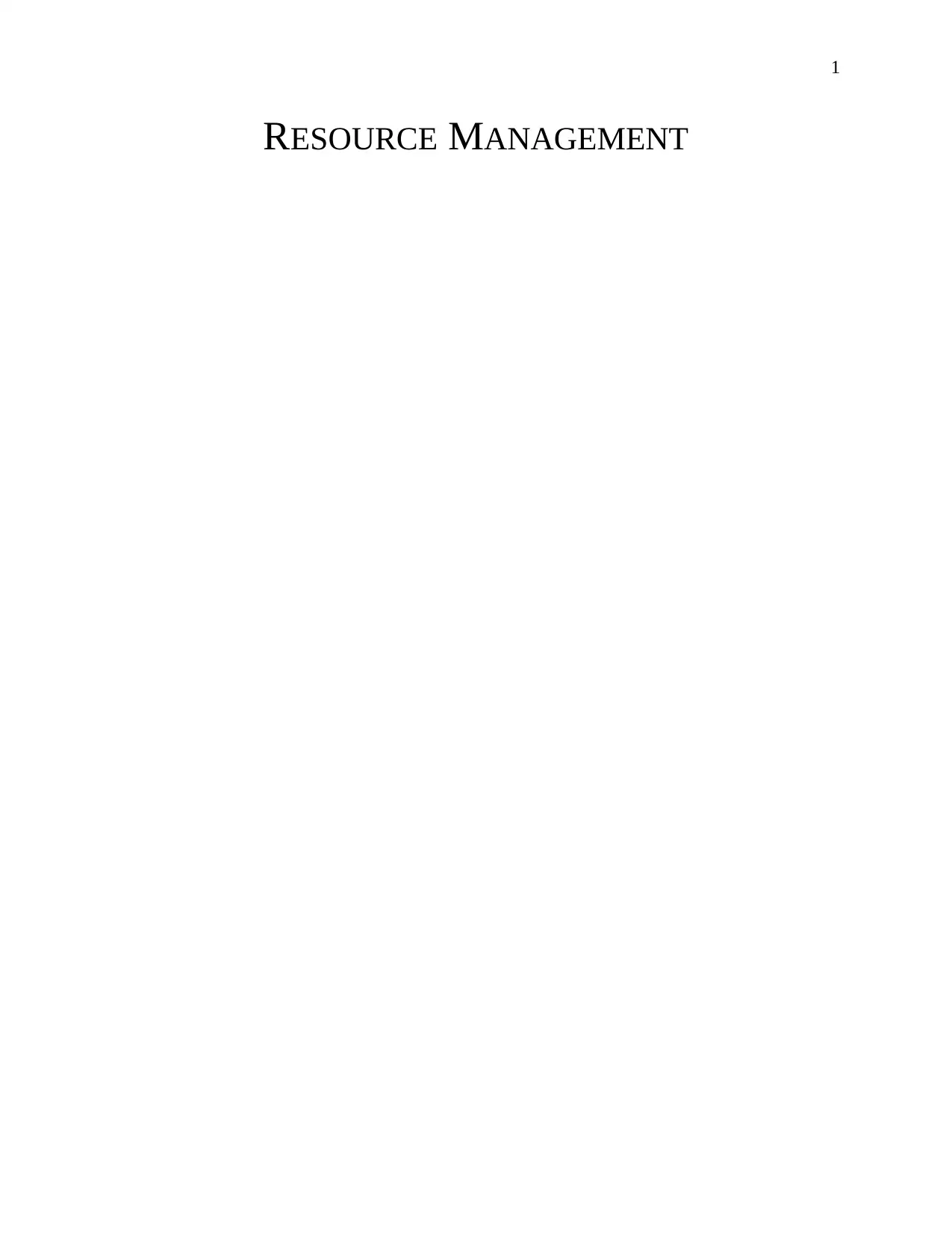
1
RESOURCE MANAGEMENT
RESOURCE MANAGEMENT
Secure Best Marks with AI Grader
Need help grading? Try our AI Grader for instant feedback on your assignments.
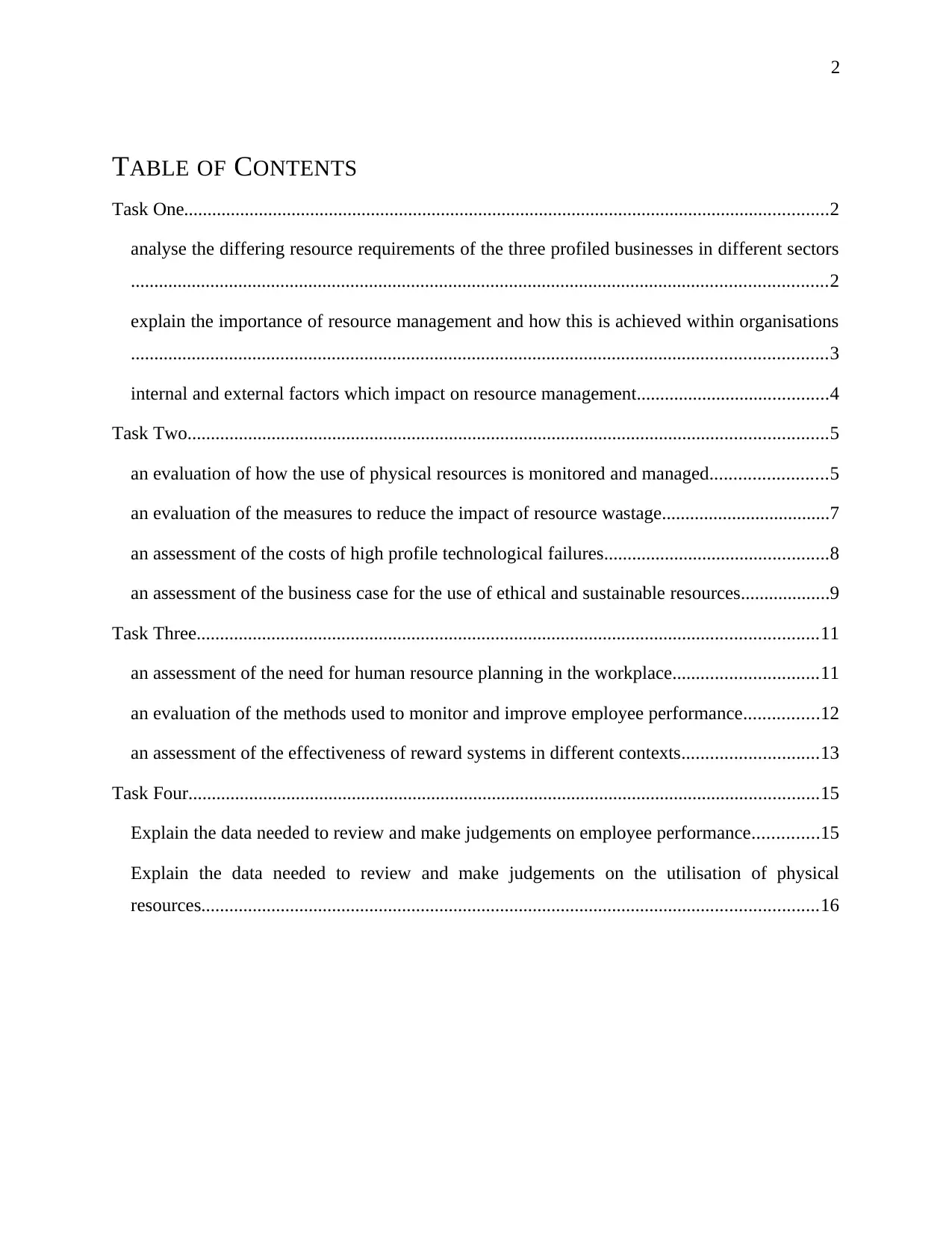
2
TABLE OF CONTENTS
Task One..........................................................................................................................................2
analyse the differing resource requirements of the three profiled businesses in different sectors
.....................................................................................................................................................2
explain the importance of resource management and how this is achieved within organisations
.....................................................................................................................................................3
internal and external factors which impact on resource management.........................................4
Task Two.........................................................................................................................................5
an evaluation of how the use of physical resources is monitored and managed.........................5
an evaluation of the measures to reduce the impact of resource wastage....................................7
an assessment of the costs of high profile technological failures................................................8
an assessment of the business case for the use of ethical and sustainable resources...................9
Task Three.....................................................................................................................................11
an assessment of the need for human resource planning in the workplace...............................11
an evaluation of the methods used to monitor and improve employee performance................12
an assessment of the effectiveness of reward systems in different contexts.............................13
Task Four.......................................................................................................................................15
Explain the data needed to review and make judgements on employee performance..............15
Explain the data needed to review and make judgements on the utilisation of physical
resources....................................................................................................................................16
TABLE OF CONTENTS
Task One..........................................................................................................................................2
analyse the differing resource requirements of the three profiled businesses in different sectors
.....................................................................................................................................................2
explain the importance of resource management and how this is achieved within organisations
.....................................................................................................................................................3
internal and external factors which impact on resource management.........................................4
Task Two.........................................................................................................................................5
an evaluation of how the use of physical resources is monitored and managed.........................5
an evaluation of the measures to reduce the impact of resource wastage....................................7
an assessment of the costs of high profile technological failures................................................8
an assessment of the business case for the use of ethical and sustainable resources...................9
Task Three.....................................................................................................................................11
an assessment of the need for human resource planning in the workplace...............................11
an evaluation of the methods used to monitor and improve employee performance................12
an assessment of the effectiveness of reward systems in different contexts.............................13
Task Four.......................................................................................................................................15
Explain the data needed to review and make judgements on employee performance..............15
Explain the data needed to review and make judgements on the utilisation of physical
resources....................................................................................................................................16
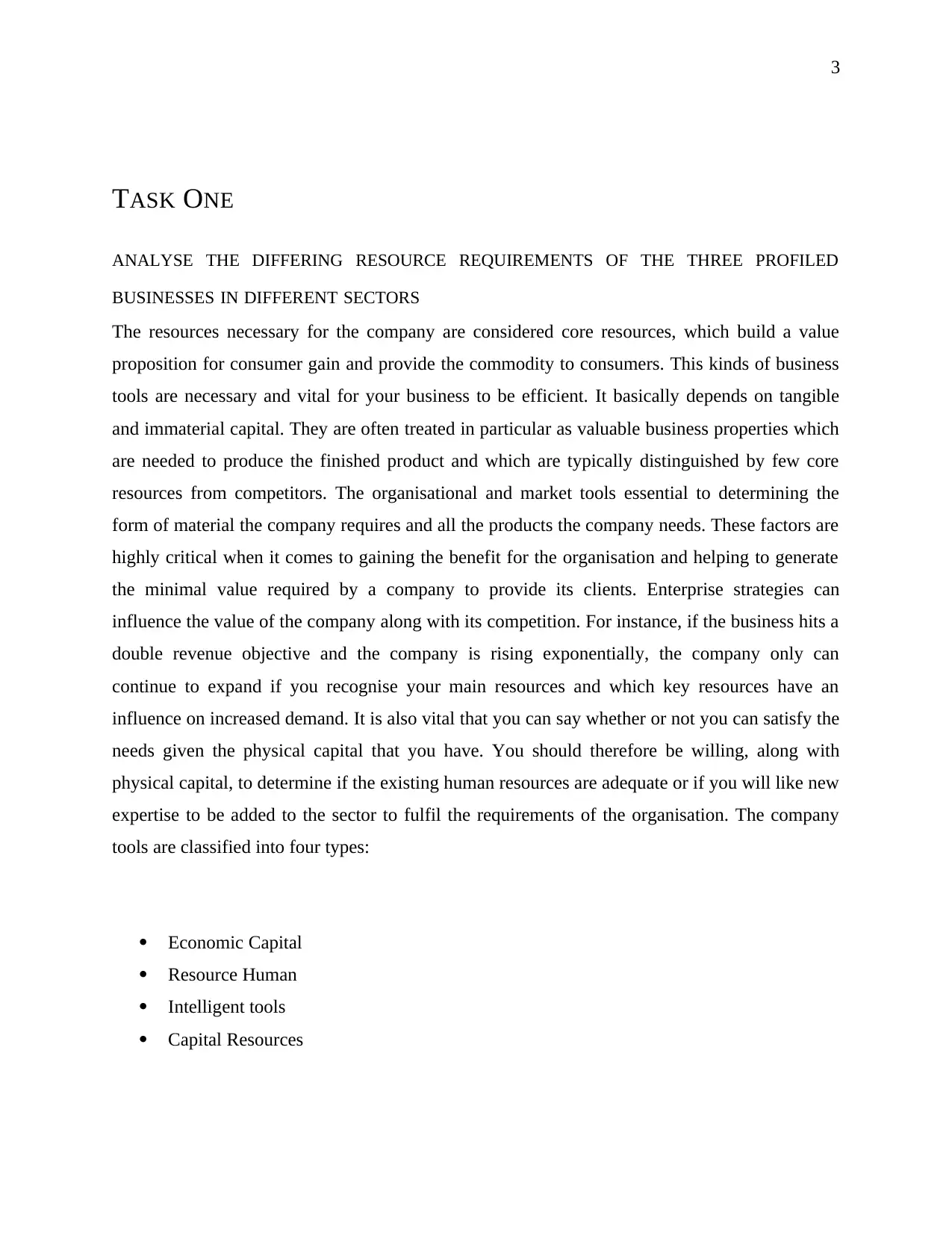
3
TASK ONE
ANALYSE THE DIFFERING RESOURCE REQUIREMENTS OF THE THREE PROFILED
BUSINESSES IN DIFFERENT SECTORS
The resources necessary for the company are considered core resources, which build a value
proposition for consumer gain and provide the commodity to consumers. This kinds of business
tools are necessary and vital for your business to be efficient. It basically depends on tangible
and immaterial capital. They are often treated in particular as valuable business properties which
are needed to produce the finished product and which are typically distinguished by few core
resources from competitors. The organisational and market tools essential to determining the
form of material the company requires and all the products the company needs. These factors are
highly critical when it comes to gaining the benefit for the organisation and helping to generate
the minimal value required by a company to provide its clients. Enterprise strategies can
influence the value of the company along with its competition. For instance, if the business hits a
double revenue objective and the company is rising exponentially, the company only can
continue to expand if you recognise your main resources and which key resources have an
influence on increased demand. It is also vital that you can say whether or not you can satisfy the
needs given the physical capital that you have. You should therefore be willing, along with
physical capital, to determine if the existing human resources are adequate or if you will like new
expertise to be added to the sector to fulfil the requirements of the organisation. The company
tools are classified into four types:
Economic Capital
Resource Human
Intelligent tools
Capital Resources
TASK ONE
ANALYSE THE DIFFERING RESOURCE REQUIREMENTS OF THE THREE PROFILED
BUSINESSES IN DIFFERENT SECTORS
The resources necessary for the company are considered core resources, which build a value
proposition for consumer gain and provide the commodity to consumers. This kinds of business
tools are necessary and vital for your business to be efficient. It basically depends on tangible
and immaterial capital. They are often treated in particular as valuable business properties which
are needed to produce the finished product and which are typically distinguished by few core
resources from competitors. The organisational and market tools essential to determining the
form of material the company requires and all the products the company needs. These factors are
highly critical when it comes to gaining the benefit for the organisation and helping to generate
the minimal value required by a company to provide its clients. Enterprise strategies can
influence the value of the company along with its competition. For instance, if the business hits a
double revenue objective and the company is rising exponentially, the company only can
continue to expand if you recognise your main resources and which key resources have an
influence on increased demand. It is also vital that you can say whether or not you can satisfy the
needs given the physical capital that you have. You should therefore be willing, along with
physical capital, to determine if the existing human resources are adequate or if you will like new
expertise to be added to the sector to fulfil the requirements of the organisation. The company
tools are classified into four types:
Economic Capital
Resource Human
Intelligent tools
Capital Resources
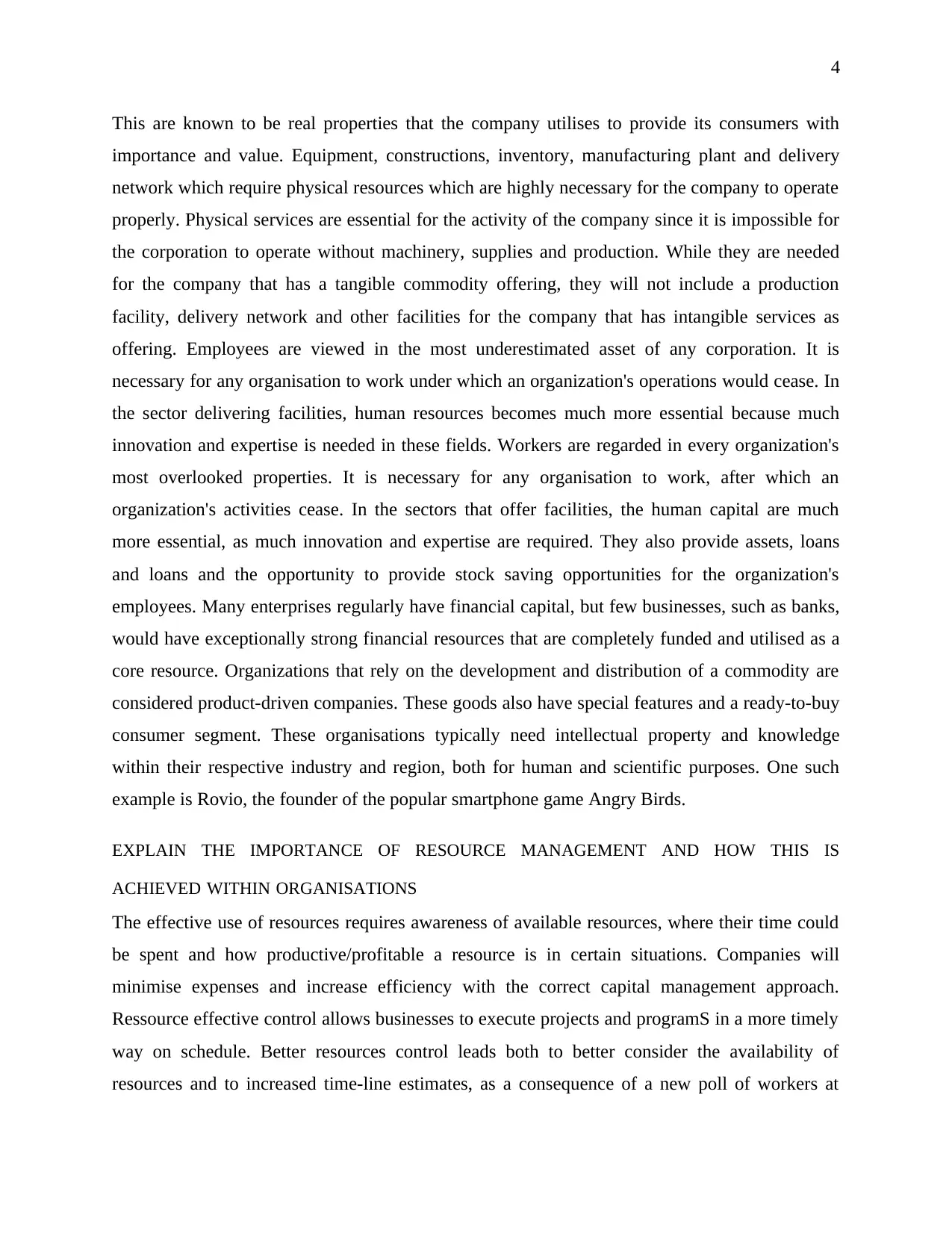
4
This are known to be real properties that the company utilises to provide its consumers with
importance and value. Equipment, constructions, inventory, manufacturing plant and delivery
network which require physical resources which are highly necessary for the company to operate
properly. Physical services are essential for the activity of the company since it is impossible for
the corporation to operate without machinery, supplies and production. While they are needed
for the company that has a tangible commodity offering, they will not include a production
facility, delivery network and other facilities for the company that has intangible services as
offering. Employees are viewed in the most underestimated asset of any corporation. It is
necessary for any organisation to work under which an organization's operations would cease. In
the sector delivering facilities, human resources becomes much more essential because much
innovation and expertise is needed in these fields. Workers are regarded in every organization's
most overlooked properties. It is necessary for any organisation to work, after which an
organization's activities cease. In the sectors that offer facilities, the human capital are much
more essential, as much innovation and expertise are required. They also provide assets, loans
and loans and the opportunity to provide stock saving opportunities for the organization's
employees. Many enterprises regularly have financial capital, but few businesses, such as banks,
would have exceptionally strong financial resources that are completely funded and utilised as a
core resource. Organizations that rely on the development and distribution of a commodity are
considered product-driven companies. These goods also have special features and a ready-to-buy
consumer segment. These organisations typically need intellectual property and knowledge
within their respective industry and region, both for human and scientific purposes. One such
example is Rovio, the founder of the popular smartphone game Angry Birds.
EXPLAIN THE IMPORTANCE OF RESOURCE MANAGEMENT AND HOW THIS IS
ACHIEVED WITHIN ORGANISATIONS
The effective use of resources requires awareness of available resources, where their time could
be spent and how productive/profitable a resource is in certain situations. Companies will
minimise expenses and increase efficiency with the correct capital management approach.
Ressource effective control allows businesses to execute projects and programS in a more timely
way on schedule. Better resources control leads both to better consider the availability of
resources and to increased time-line estimates, as a consequence of a new poll of workers at
This are known to be real properties that the company utilises to provide its consumers with
importance and value. Equipment, constructions, inventory, manufacturing plant and delivery
network which require physical resources which are highly necessary for the company to operate
properly. Physical services are essential for the activity of the company since it is impossible for
the corporation to operate without machinery, supplies and production. While they are needed
for the company that has a tangible commodity offering, they will not include a production
facility, delivery network and other facilities for the company that has intangible services as
offering. Employees are viewed in the most underestimated asset of any corporation. It is
necessary for any organisation to work under which an organization's operations would cease. In
the sector delivering facilities, human resources becomes much more essential because much
innovation and expertise is needed in these fields. Workers are regarded in every organization's
most overlooked properties. It is necessary for any organisation to work, after which an
organization's activities cease. In the sectors that offer facilities, the human capital are much
more essential, as much innovation and expertise are required. They also provide assets, loans
and loans and the opportunity to provide stock saving opportunities for the organization's
employees. Many enterprises regularly have financial capital, but few businesses, such as banks,
would have exceptionally strong financial resources that are completely funded and utilised as a
core resource. Organizations that rely on the development and distribution of a commodity are
considered product-driven companies. These goods also have special features and a ready-to-buy
consumer segment. These organisations typically need intellectual property and knowledge
within their respective industry and region, both for human and scientific purposes. One such
example is Rovio, the founder of the popular smartphone game Angry Birds.
EXPLAIN THE IMPORTANCE OF RESOURCE MANAGEMENT AND HOW THIS IS
ACHIEVED WITHIN ORGANISATIONS
The effective use of resources requires awareness of available resources, where their time could
be spent and how productive/profitable a resource is in certain situations. Companies will
minimise expenses and increase efficiency with the correct capital management approach.
Ressource effective control allows businesses to execute projects and programS in a more timely
way on schedule. Better resources control leads both to better consider the availability of
resources and to increased time-line estimates, as a consequence of a new poll of workers at
Secure Best Marks with AI Grader
Need help grading? Try our AI Grader for instant feedback on your assignments.
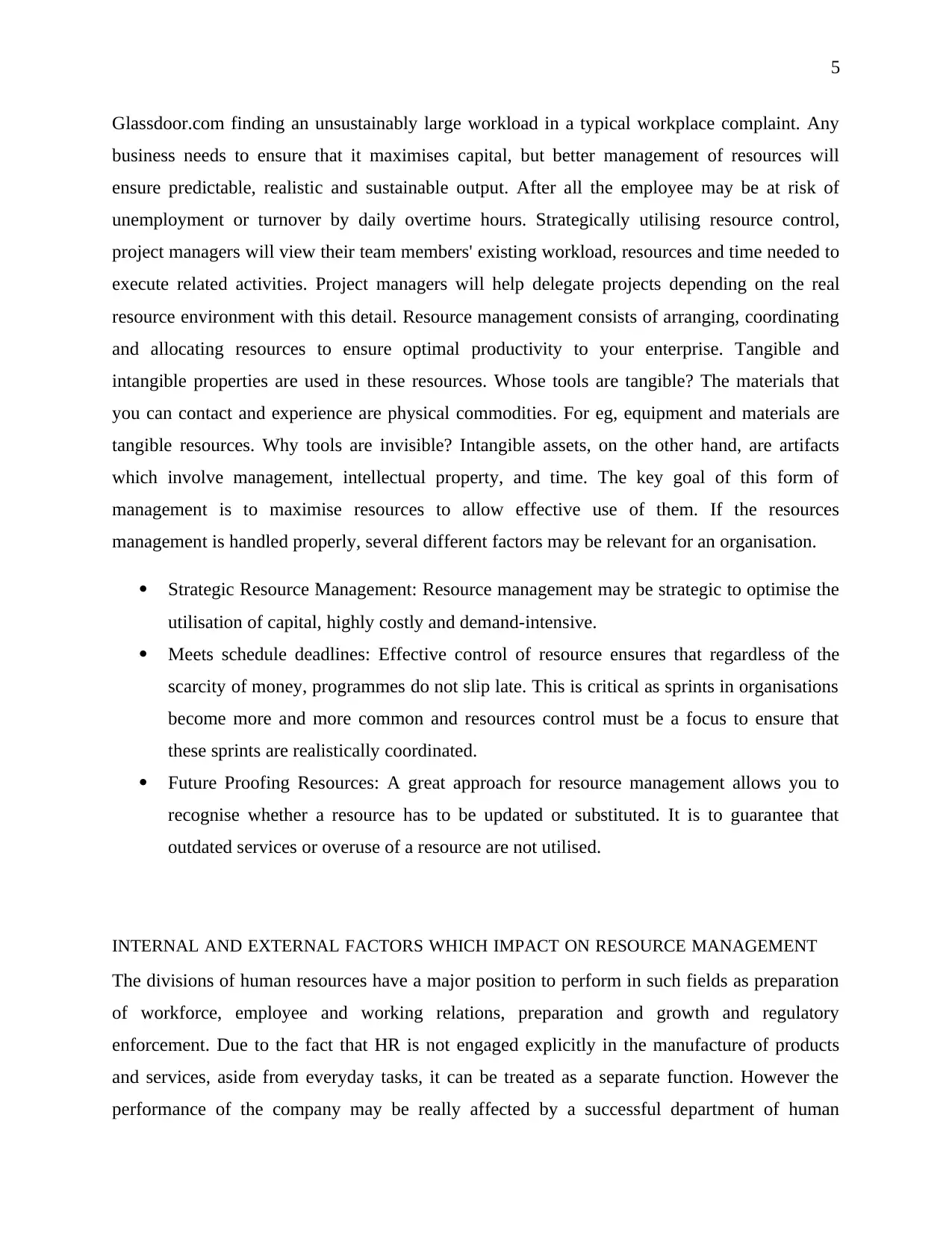
5
Glassdoor.com finding an unsustainably large workload in a typical workplace complaint. Any
business needs to ensure that it maximises capital, but better management of resources will
ensure predictable, realistic and sustainable output. After all the employee may be at risk of
unemployment or turnover by daily overtime hours. Strategically utilising resource control,
project managers will view their team members' existing workload, resources and time needed to
execute related activities. Project managers will help delegate projects depending on the real
resource environment with this detail. Resource management consists of arranging, coordinating
and allocating resources to ensure optimal productivity to your enterprise. Tangible and
intangible properties are used in these resources. Whose tools are tangible? The materials that
you can contact and experience are physical commodities. For eg, equipment and materials are
tangible resources. Why tools are invisible? Intangible assets, on the other hand, are artifacts
which involve management, intellectual property, and time. The key goal of this form of
management is to maximise resources to allow effective use of them. If the resources
management is handled properly, several different factors may be relevant for an organisation.
Strategic Resource Management: Resource management may be strategic to optimise the
utilisation of capital, highly costly and demand-intensive.
Meets schedule deadlines: Effective control of resource ensures that regardless of the
scarcity of money, programmes do not slip late. This is critical as sprints in organisations
become more and more common and resources control must be a focus to ensure that
these sprints are realistically coordinated.
Future Proofing Resources: A great approach for resource management allows you to
recognise whether a resource has to be updated or substituted. It is to guarantee that
outdated services or overuse of a resource are not utilised.
INTERNAL AND EXTERNAL FACTORS WHICH IMPACT ON RESOURCE MANAGEMENT
The divisions of human resources have a major position to perform in such fields as preparation
of workforce, employee and working relations, preparation and growth and regulatory
enforcement. Due to the fact that HR is not engaged explicitly in the manufacture of products
and services, aside from everyday tasks, it can be treated as a separate function. However the
performance of the company may be really affected by a successful department of human
Glassdoor.com finding an unsustainably large workload in a typical workplace complaint. Any
business needs to ensure that it maximises capital, but better management of resources will
ensure predictable, realistic and sustainable output. After all the employee may be at risk of
unemployment or turnover by daily overtime hours. Strategically utilising resource control,
project managers will view their team members' existing workload, resources and time needed to
execute related activities. Project managers will help delegate projects depending on the real
resource environment with this detail. Resource management consists of arranging, coordinating
and allocating resources to ensure optimal productivity to your enterprise. Tangible and
intangible properties are used in these resources. Whose tools are tangible? The materials that
you can contact and experience are physical commodities. For eg, equipment and materials are
tangible resources. Why tools are invisible? Intangible assets, on the other hand, are artifacts
which involve management, intellectual property, and time. The key goal of this form of
management is to maximise resources to allow effective use of them. If the resources
management is handled properly, several different factors may be relevant for an organisation.
Strategic Resource Management: Resource management may be strategic to optimise the
utilisation of capital, highly costly and demand-intensive.
Meets schedule deadlines: Effective control of resource ensures that regardless of the
scarcity of money, programmes do not slip late. This is critical as sprints in organisations
become more and more common and resources control must be a focus to ensure that
these sprints are realistically coordinated.
Future Proofing Resources: A great approach for resource management allows you to
recognise whether a resource has to be updated or substituted. It is to guarantee that
outdated services or overuse of a resource are not utilised.
INTERNAL AND EXTERNAL FACTORS WHICH IMPACT ON RESOURCE MANAGEMENT
The divisions of human resources have a major position to perform in such fields as preparation
of workforce, employee and working relations, preparation and growth and regulatory
enforcement. Due to the fact that HR is not engaged explicitly in the manufacture of products
and services, aside from everyday tasks, it can be treated as a separate function. However the
performance of the company may be really affected by a successful department of human
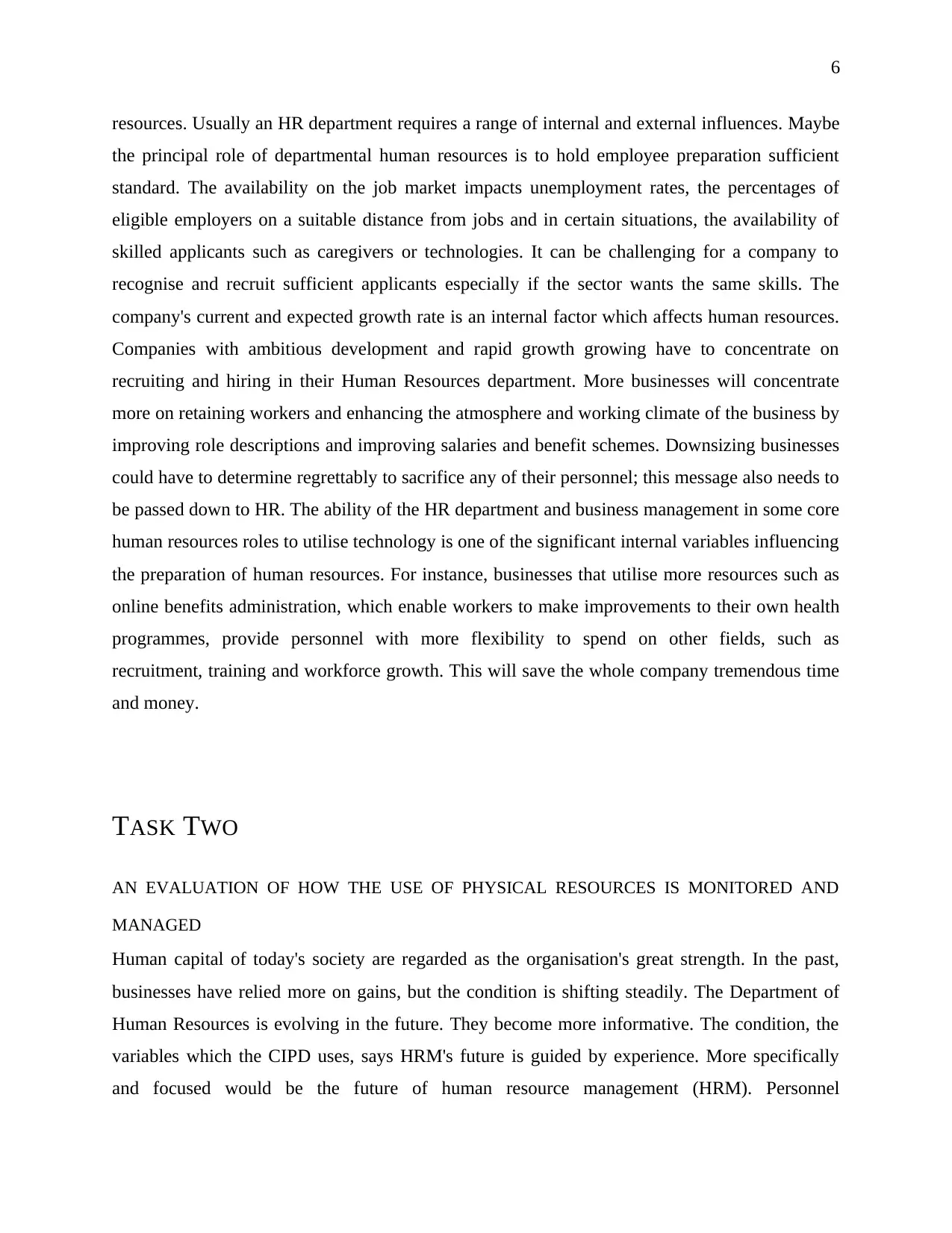
6
resources. Usually an HR department requires a range of internal and external influences. Maybe
the principal role of departmental human resources is to hold employee preparation sufficient
standard. The availability on the job market impacts unemployment rates, the percentages of
eligible employers on a suitable distance from jobs and in certain situations, the availability of
skilled applicants such as caregivers or technologies. It can be challenging for a company to
recognise and recruit sufficient applicants especially if the sector wants the same skills. The
company's current and expected growth rate is an internal factor which affects human resources.
Companies with ambitious development and rapid growth growing have to concentrate on
recruiting and hiring in their Human Resources department. More businesses will concentrate
more on retaining workers and enhancing the atmosphere and working climate of the business by
improving role descriptions and improving salaries and benefit schemes. Downsizing businesses
could have to determine regrettably to sacrifice any of their personnel; this message also needs to
be passed down to HR. The ability of the HR department and business management in some core
human resources roles to utilise technology is one of the significant internal variables influencing
the preparation of human resources. For instance, businesses that utilise more resources such as
online benefits administration, which enable workers to make improvements to their own health
programmes, provide personnel with more flexibility to spend on other fields, such as
recruitment, training and workforce growth. This will save the whole company tremendous time
and money.
TASK TWO
AN EVALUATION OF HOW THE USE OF PHYSICAL RESOURCES IS MONITORED AND
MANAGED
Human capital of today's society are regarded as the organisation's great strength. In the past,
businesses have relied more on gains, but the condition is shifting steadily. The Department of
Human Resources is evolving in the future. They become more informative. The condition, the
variables which the CIPD uses, says HRM's future is guided by experience. More specifically
and focused would be the future of human resource management (HRM). Personnel
resources. Usually an HR department requires a range of internal and external influences. Maybe
the principal role of departmental human resources is to hold employee preparation sufficient
standard. The availability on the job market impacts unemployment rates, the percentages of
eligible employers on a suitable distance from jobs and in certain situations, the availability of
skilled applicants such as caregivers or technologies. It can be challenging for a company to
recognise and recruit sufficient applicants especially if the sector wants the same skills. The
company's current and expected growth rate is an internal factor which affects human resources.
Companies with ambitious development and rapid growth growing have to concentrate on
recruiting and hiring in their Human Resources department. More businesses will concentrate
more on retaining workers and enhancing the atmosphere and working climate of the business by
improving role descriptions and improving salaries and benefit schemes. Downsizing businesses
could have to determine regrettably to sacrifice any of their personnel; this message also needs to
be passed down to HR. The ability of the HR department and business management in some core
human resources roles to utilise technology is one of the significant internal variables influencing
the preparation of human resources. For instance, businesses that utilise more resources such as
online benefits administration, which enable workers to make improvements to their own health
programmes, provide personnel with more flexibility to spend on other fields, such as
recruitment, training and workforce growth. This will save the whole company tremendous time
and money.
TASK TWO
AN EVALUATION OF HOW THE USE OF PHYSICAL RESOURCES IS MONITORED AND
MANAGED
Human capital of today's society are regarded as the organisation's great strength. In the past,
businesses have relied more on gains, but the condition is shifting steadily. The Department of
Human Resources is evolving in the future. They become more informative. The condition, the
variables which the CIPD uses, says HRM's future is guided by experience. More specifically
and focused would be the future of human resource management (HRM). Personnel
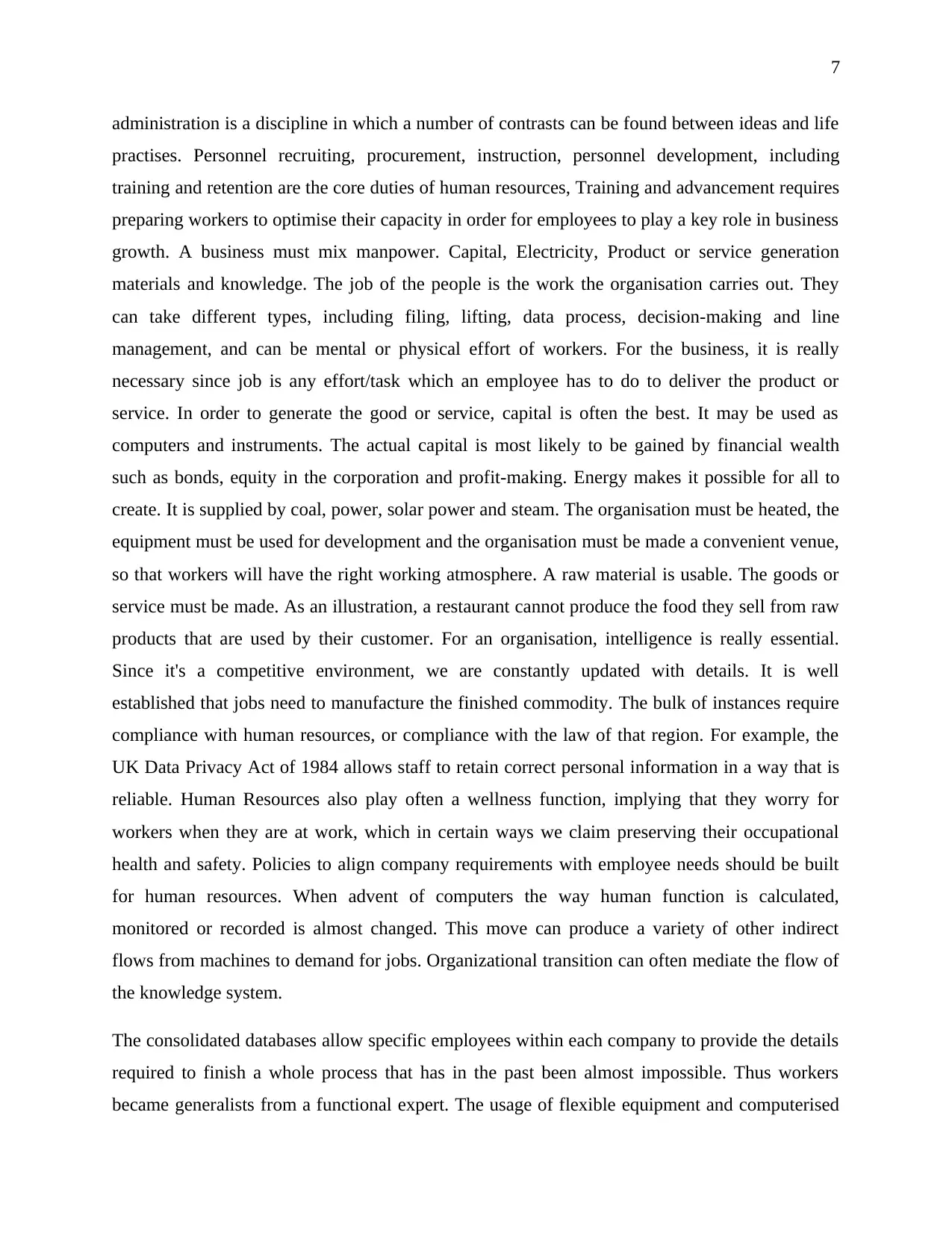
7
administration is a discipline in which a number of contrasts can be found between ideas and life
practises. Personnel recruiting, procurement, instruction, personnel development, including
training and retention are the core duties of human resources, Training and advancement requires
preparing workers to optimise their capacity in order for employees to play a key role in business
growth. A business must mix manpower. Capital, Electricity, Product or service generation
materials and knowledge. The job of the people is the work the organisation carries out. They
can take different types, including filing, lifting, data process, decision-making and line
management, and can be mental or physical effort of workers. For the business, it is really
necessary since job is any effort/task which an employee has to do to deliver the product or
service. In order to generate the good or service, capital is often the best. It may be used as
computers and instruments. The actual capital is most likely to be gained by financial wealth
such as bonds, equity in the corporation and profit-making. Energy makes it possible for all to
create. It is supplied by coal, power, solar power and steam. The organisation must be heated, the
equipment must be used for development and the organisation must be made a convenient venue,
so that workers will have the right working atmosphere. A raw material is usable. The goods or
service must be made. As an illustration, a restaurant cannot produce the food they sell from raw
products that are used by their customer. For an organisation, intelligence is really essential.
Since it's a competitive environment, we are constantly updated with details. It is well
established that jobs need to manufacture the finished commodity. The bulk of instances require
compliance with human resources, or compliance with the law of that region. For example, the
UK Data Privacy Act of 1984 allows staff to retain correct personal information in a way that is
reliable. Human Resources also play often a wellness function, implying that they worry for
workers when they are at work, which in certain ways we claim preserving their occupational
health and safety. Policies to align company requirements with employee needs should be built
for human resources. When advent of computers the way human function is calculated,
monitored or recorded is almost changed. This move can produce a variety of other indirect
flows from machines to demand for jobs. Organizational transition can often mediate the flow of
the knowledge system.
The consolidated databases allow specific employees within each company to provide the details
required to finish a whole process that has in the past been almost impossible. Thus workers
became generalists from a functional expert. The usage of flexible equipment and computerised
administration is a discipline in which a number of contrasts can be found between ideas and life
practises. Personnel recruiting, procurement, instruction, personnel development, including
training and retention are the core duties of human resources, Training and advancement requires
preparing workers to optimise their capacity in order for employees to play a key role in business
growth. A business must mix manpower. Capital, Electricity, Product or service generation
materials and knowledge. The job of the people is the work the organisation carries out. They
can take different types, including filing, lifting, data process, decision-making and line
management, and can be mental or physical effort of workers. For the business, it is really
necessary since job is any effort/task which an employee has to do to deliver the product or
service. In order to generate the good or service, capital is often the best. It may be used as
computers and instruments. The actual capital is most likely to be gained by financial wealth
such as bonds, equity in the corporation and profit-making. Energy makes it possible for all to
create. It is supplied by coal, power, solar power and steam. The organisation must be heated, the
equipment must be used for development and the organisation must be made a convenient venue,
so that workers will have the right working atmosphere. A raw material is usable. The goods or
service must be made. As an illustration, a restaurant cannot produce the food they sell from raw
products that are used by their customer. For an organisation, intelligence is really essential.
Since it's a competitive environment, we are constantly updated with details. It is well
established that jobs need to manufacture the finished commodity. The bulk of instances require
compliance with human resources, or compliance with the law of that region. For example, the
UK Data Privacy Act of 1984 allows staff to retain correct personal information in a way that is
reliable. Human Resources also play often a wellness function, implying that they worry for
workers when they are at work, which in certain ways we claim preserving their occupational
health and safety. Policies to align company requirements with employee needs should be built
for human resources. When advent of computers the way human function is calculated,
monitored or recorded is almost changed. This move can produce a variety of other indirect
flows from machines to demand for jobs. Organizational transition can often mediate the flow of
the knowledge system.
The consolidated databases allow specific employees within each company to provide the details
required to finish a whole process that has in the past been almost impossible. Thus workers
became generalists from a functional expert. The usage of flexible equipment and computerised
Paraphrase This Document
Need a fresh take? Get an instant paraphrase of this document with our AI Paraphraser
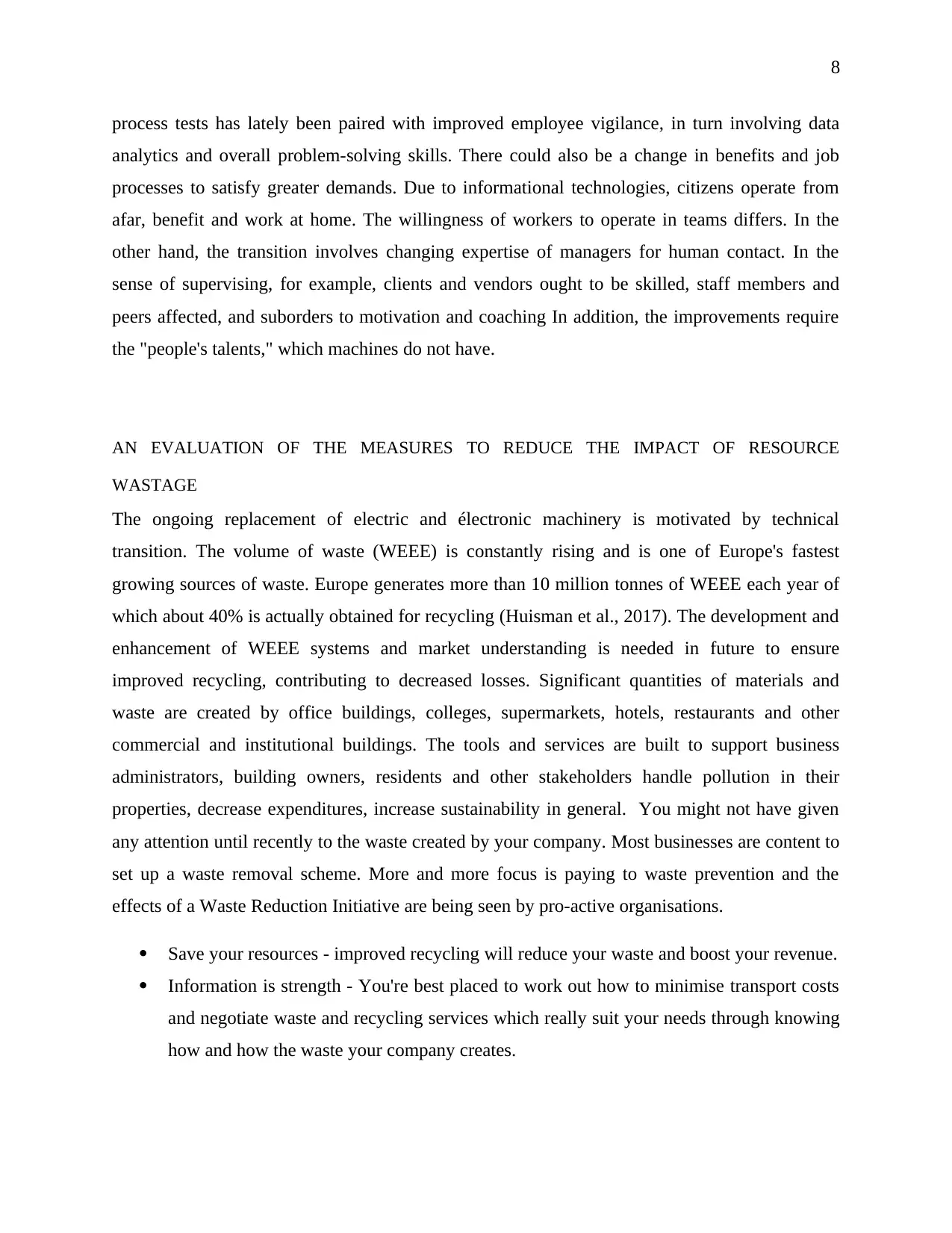
8
process tests has lately been paired with improved employee vigilance, in turn involving data
analytics and overall problem-solving skills. There could also be a change in benefits and job
processes to satisfy greater demands. Due to informational technologies, citizens operate from
afar, benefit and work at home. The willingness of workers to operate in teams differs. In the
other hand, the transition involves changing expertise of managers for human contact. In the
sense of supervising, for example, clients and vendors ought to be skilled, staff members and
peers affected, and suborders to motivation and coaching In addition, the improvements require
the "people's talents," which machines do not have.
AN EVALUATION OF THE MEASURES TO REDUCE THE IMPACT OF RESOURCE
WASTAGE
The ongoing replacement of electric and électronic machinery is motivated by technical
transition. The volume of waste (WEEE) is constantly rising and is one of Europe's fastest
growing sources of waste. Europe generates more than 10 million tonnes of WEEE each year of
which about 40% is actually obtained for recycling (Huisman et al., 2017). The development and
enhancement of WEEE systems and market understanding is needed in future to ensure
improved recycling, contributing to decreased losses. Significant quantities of materials and
waste are created by office buildings, colleges, supermarkets, hotels, restaurants and other
commercial and institutional buildings. The tools and services are built to support business
administrators, building owners, residents and other stakeholders handle pollution in their
properties, decrease expenditures, increase sustainability in general. You might not have given
any attention until recently to the waste created by your company. Most businesses are content to
set up a waste removal scheme. More and more focus is paying to waste prevention and the
effects of a Waste Reduction Initiative are being seen by pro-active organisations.
Save your resources - improved recycling will reduce your waste and boost your revenue.
Information is strength - You're best placed to work out how to minimise transport costs
and negotiate waste and recycling services which really suit your needs through knowing
how and how the waste your company creates.
process tests has lately been paired with improved employee vigilance, in turn involving data
analytics and overall problem-solving skills. There could also be a change in benefits and job
processes to satisfy greater demands. Due to informational technologies, citizens operate from
afar, benefit and work at home. The willingness of workers to operate in teams differs. In the
other hand, the transition involves changing expertise of managers for human contact. In the
sense of supervising, for example, clients and vendors ought to be skilled, staff members and
peers affected, and suborders to motivation and coaching In addition, the improvements require
the "people's talents," which machines do not have.
AN EVALUATION OF THE MEASURES TO REDUCE THE IMPACT OF RESOURCE
WASTAGE
The ongoing replacement of electric and électronic machinery is motivated by technical
transition. The volume of waste (WEEE) is constantly rising and is one of Europe's fastest
growing sources of waste. Europe generates more than 10 million tonnes of WEEE each year of
which about 40% is actually obtained for recycling (Huisman et al., 2017). The development and
enhancement of WEEE systems and market understanding is needed in future to ensure
improved recycling, contributing to decreased losses. Significant quantities of materials and
waste are created by office buildings, colleges, supermarkets, hotels, restaurants and other
commercial and institutional buildings. The tools and services are built to support business
administrators, building owners, residents and other stakeholders handle pollution in their
properties, decrease expenditures, increase sustainability in general. You might not have given
any attention until recently to the waste created by your company. Most businesses are content to
set up a waste removal scheme. More and more focus is paying to waste prevention and the
effects of a Waste Reduction Initiative are being seen by pro-active organisations.
Save your resources - improved recycling will reduce your waste and boost your revenue.
Information is strength - You're best placed to work out how to minimise transport costs
and negotiate waste and recycling services which really suit your needs through knowing
how and how the waste your company creates.
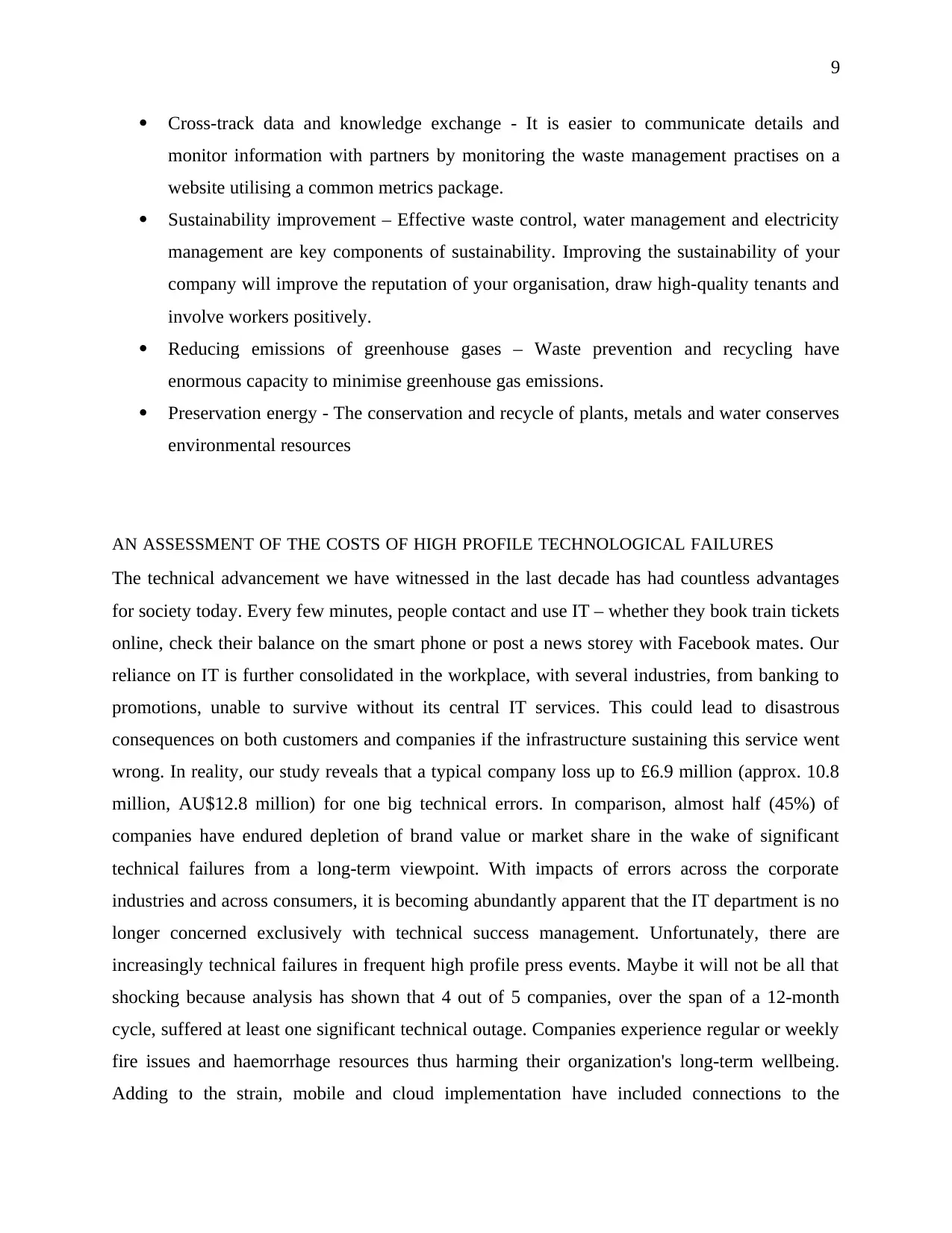
9
Cross-track data and knowledge exchange - It is easier to communicate details and
monitor information with partners by monitoring the waste management practises on a
website utilising a common metrics package.
Sustainability improvement – Effective waste control, water management and electricity
management are key components of sustainability. Improving the sustainability of your
company will improve the reputation of your organisation, draw high-quality tenants and
involve workers positively.
Reducing emissions of greenhouse gases – Waste prevention and recycling have
enormous capacity to minimise greenhouse gas emissions.
Preservation energy - The conservation and recycle of plants, metals and water conserves
environmental resources
AN ASSESSMENT OF THE COSTS OF HIGH PROFILE TECHNOLOGICAL FAILURES
The technical advancement we have witnessed in the last decade has had countless advantages
for society today. Every few minutes, people contact and use IT – whether they book train tickets
online, check their balance on the smart phone or post a news storey with Facebook mates. Our
reliance on IT is further consolidated in the workplace, with several industries, from banking to
promotions, unable to survive without its central IT services. This could lead to disastrous
consequences on both customers and companies if the infrastructure sustaining this service went
wrong. In reality, our study reveals that a typical company loss up to £6.9 million (approx. 10.8
million, AU$12.8 million) for one big technical errors. In comparison, almost half (45%) of
companies have endured depletion of brand value or market share in the wake of significant
technical failures from a long-term viewpoint. With impacts of errors across the corporate
industries and across consumers, it is becoming abundantly apparent that the IT department is no
longer concerned exclusively with technical success management. Unfortunately, there are
increasingly technical failures in frequent high profile press events. Maybe it will not be all that
shocking because analysis has shown that 4 out of 5 companies, over the span of a 12-month
cycle, suffered at least one significant technical outage. Companies experience regular or weekly
fire issues and haemorrhage resources thus harming their organization's long-term wellbeing.
Adding to the strain, mobile and cloud implementation have included connections to the
Cross-track data and knowledge exchange - It is easier to communicate details and
monitor information with partners by monitoring the waste management practises on a
website utilising a common metrics package.
Sustainability improvement – Effective waste control, water management and electricity
management are key components of sustainability. Improving the sustainability of your
company will improve the reputation of your organisation, draw high-quality tenants and
involve workers positively.
Reducing emissions of greenhouse gases – Waste prevention and recycling have
enormous capacity to minimise greenhouse gas emissions.
Preservation energy - The conservation and recycle of plants, metals and water conserves
environmental resources
AN ASSESSMENT OF THE COSTS OF HIGH PROFILE TECHNOLOGICAL FAILURES
The technical advancement we have witnessed in the last decade has had countless advantages
for society today. Every few minutes, people contact and use IT – whether they book train tickets
online, check their balance on the smart phone or post a news storey with Facebook mates. Our
reliance on IT is further consolidated in the workplace, with several industries, from banking to
promotions, unable to survive without its central IT services. This could lead to disastrous
consequences on both customers and companies if the infrastructure sustaining this service went
wrong. In reality, our study reveals that a typical company loss up to £6.9 million (approx. 10.8
million, AU$12.8 million) for one big technical errors. In comparison, almost half (45%) of
companies have endured depletion of brand value or market share in the wake of significant
technical failures from a long-term viewpoint. With impacts of errors across the corporate
industries and across consumers, it is becoming abundantly apparent that the IT department is no
longer concerned exclusively with technical success management. Unfortunately, there are
increasingly technical failures in frequent high profile press events. Maybe it will not be all that
shocking because analysis has shown that 4 out of 5 companies, over the span of a 12-month
cycle, suffered at least one significant technical outage. Companies experience regular or weekly
fire issues and haemorrhage resources thus harming their organization's long-term wellbeing.
Adding to the strain, mobile and cloud implementation have included connections to the
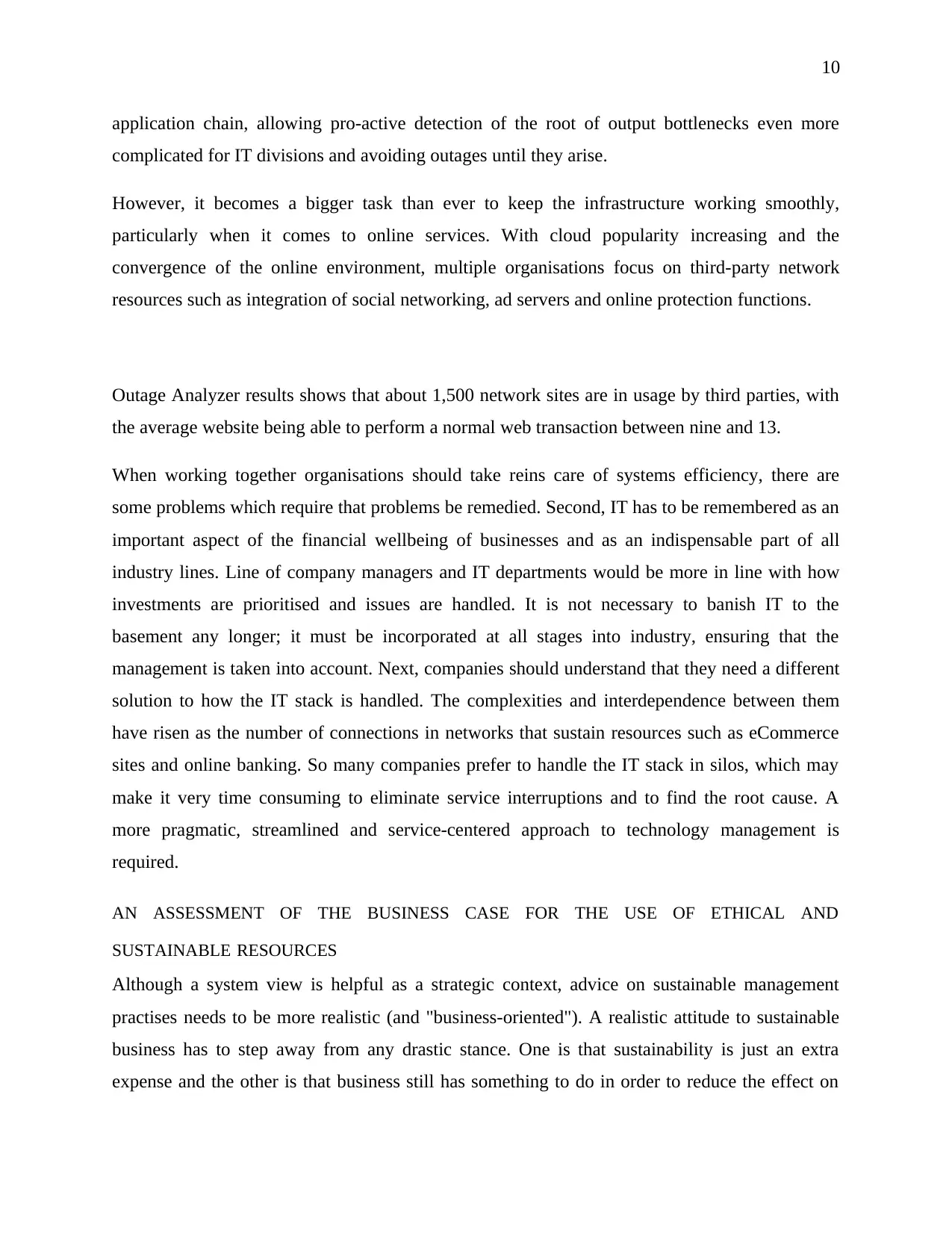
10
application chain, allowing pro-active detection of the root of output bottlenecks even more
complicated for IT divisions and avoiding outages until they arise.
However, it becomes a bigger task than ever to keep the infrastructure working smoothly,
particularly when it comes to online services. With cloud popularity increasing and the
convergence of the online environment, multiple organisations focus on third-party network
resources such as integration of social networking, ad servers and online protection functions.
Outage Analyzer results shows that about 1,500 network sites are in usage by third parties, with
the average website being able to perform a normal web transaction between nine and 13.
When working together organisations should take reins care of systems efficiency, there are
some problems which require that problems be remedied. Second, IT has to be remembered as an
important aspect of the financial wellbeing of businesses and as an indispensable part of all
industry lines. Line of company managers and IT departments would be more in line with how
investments are prioritised and issues are handled. It is not necessary to banish IT to the
basement any longer; it must be incorporated at all stages into industry, ensuring that the
management is taken into account. Next, companies should understand that they need a different
solution to how the IT stack is handled. The complexities and interdependence between them
have risen as the number of connections in networks that sustain resources such as eCommerce
sites and online banking. So many companies prefer to handle the IT stack in silos, which may
make it very time consuming to eliminate service interruptions and to find the root cause. A
more pragmatic, streamlined and service-centered approach to technology management is
required.
AN ASSESSMENT OF THE BUSINESS CASE FOR THE USE OF ETHICAL AND
SUSTAINABLE RESOURCES
Although a system view is helpful as a strategic context, advice on sustainable management
practises needs to be more realistic (and "business-oriented"). A realistic attitude to sustainable
business has to step away from any drastic stance. One is that sustainability is just an extra
expense and the other is that business still has something to do in order to reduce the effect on
application chain, allowing pro-active detection of the root of output bottlenecks even more
complicated for IT divisions and avoiding outages until they arise.
However, it becomes a bigger task than ever to keep the infrastructure working smoothly,
particularly when it comes to online services. With cloud popularity increasing and the
convergence of the online environment, multiple organisations focus on third-party network
resources such as integration of social networking, ad servers and online protection functions.
Outage Analyzer results shows that about 1,500 network sites are in usage by third parties, with
the average website being able to perform a normal web transaction between nine and 13.
When working together organisations should take reins care of systems efficiency, there are
some problems which require that problems be remedied. Second, IT has to be remembered as an
important aspect of the financial wellbeing of businesses and as an indispensable part of all
industry lines. Line of company managers and IT departments would be more in line with how
investments are prioritised and issues are handled. It is not necessary to banish IT to the
basement any longer; it must be incorporated at all stages into industry, ensuring that the
management is taken into account. Next, companies should understand that they need a different
solution to how the IT stack is handled. The complexities and interdependence between them
have risen as the number of connections in networks that sustain resources such as eCommerce
sites and online banking. So many companies prefer to handle the IT stack in silos, which may
make it very time consuming to eliminate service interruptions and to find the root cause. A
more pragmatic, streamlined and service-centered approach to technology management is
required.
AN ASSESSMENT OF THE BUSINESS CASE FOR THE USE OF ETHICAL AND
SUSTAINABLE RESOURCES
Although a system view is helpful as a strategic context, advice on sustainable management
practises needs to be more realistic (and "business-oriented"). A realistic attitude to sustainable
business has to step away from any drastic stance. One is that sustainability is just an extra
expense and the other is that business still has something to do in order to reduce the effect on
Secure Best Marks with AI Grader
Need help grading? Try our AI Grader for instant feedback on your assignments.
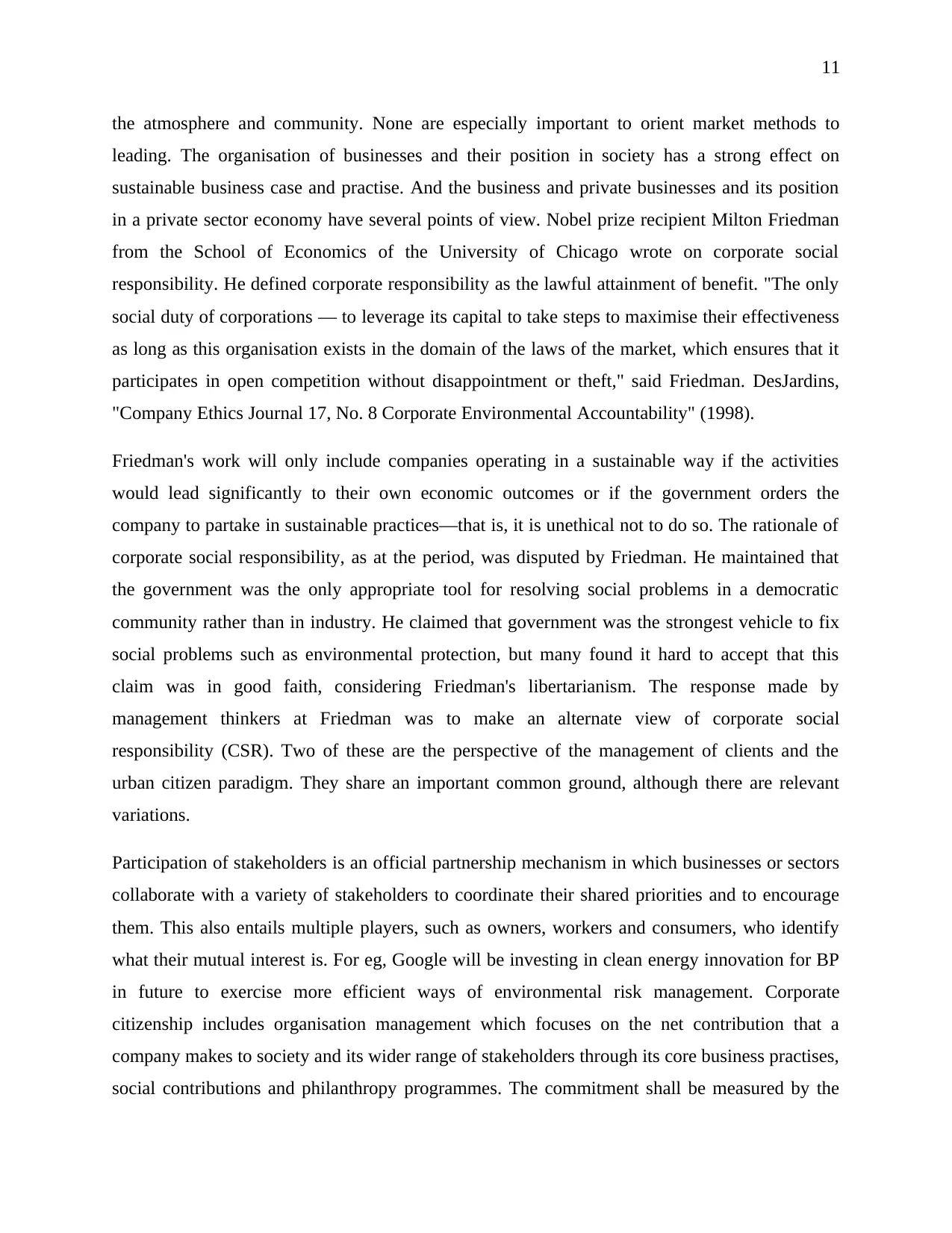
11
the atmosphere and community. None are especially important to orient market methods to
leading. The organisation of businesses and their position in society has a strong effect on
sustainable business case and practise. And the business and private businesses and its position
in a private sector economy have several points of view. Nobel prize recipient Milton Friedman
from the School of Economics of the University of Chicago wrote on corporate social
responsibility. He defined corporate responsibility as the lawful attainment of benefit. "The only
social duty of corporations — to leverage its capital to take steps to maximise their effectiveness
as long as this organisation exists in the domain of the laws of the market, which ensures that it
participates in open competition without disappointment or theft," said Friedman. DesJardins,
"Company Ethics Journal 17, No. 8 Corporate Environmental Accountability" (1998).
Friedman's work will only include companies operating in a sustainable way if the activities
would lead significantly to their own economic outcomes or if the government orders the
company to partake in sustainable practices—that is, it is unethical not to do so. The rationale of
corporate social responsibility, as at the period, was disputed by Friedman. He maintained that
the government was the only appropriate tool for resolving social problems in a democratic
community rather than in industry. He claimed that government was the strongest vehicle to fix
social problems such as environmental protection, but many found it hard to accept that this
claim was in good faith, considering Friedman's libertarianism. The response made by
management thinkers at Friedman was to make an alternate view of corporate social
responsibility (CSR). Two of these are the perspective of the management of clients and the
urban citizen paradigm. They share an important common ground, although there are relevant
variations.
Participation of stakeholders is an official partnership mechanism in which businesses or sectors
collaborate with a variety of stakeholders to coordinate their shared priorities and to encourage
them. This also entails multiple players, such as owners, workers and consumers, who identify
what their mutual interest is. For eg, Google will be investing in clean energy innovation for BP
in future to exercise more efficient ways of environmental risk management. Corporate
citizenship includes organisation management which focuses on the net contribution that a
company makes to society and its wider range of stakeholders through its core business practises,
social contributions and philanthropy programmes. The commitment shall be measured by the
the atmosphere and community. None are especially important to orient market methods to
leading. The organisation of businesses and their position in society has a strong effect on
sustainable business case and practise. And the business and private businesses and its position
in a private sector economy have several points of view. Nobel prize recipient Milton Friedman
from the School of Economics of the University of Chicago wrote on corporate social
responsibility. He defined corporate responsibility as the lawful attainment of benefit. "The only
social duty of corporations — to leverage its capital to take steps to maximise their effectiveness
as long as this organisation exists in the domain of the laws of the market, which ensures that it
participates in open competition without disappointment or theft," said Friedman. DesJardins,
"Company Ethics Journal 17, No. 8 Corporate Environmental Accountability" (1998).
Friedman's work will only include companies operating in a sustainable way if the activities
would lead significantly to their own economic outcomes or if the government orders the
company to partake in sustainable practices—that is, it is unethical not to do so. The rationale of
corporate social responsibility, as at the period, was disputed by Friedman. He maintained that
the government was the only appropriate tool for resolving social problems in a democratic
community rather than in industry. He claimed that government was the strongest vehicle to fix
social problems such as environmental protection, but many found it hard to accept that this
claim was in good faith, considering Friedman's libertarianism. The response made by
management thinkers at Friedman was to make an alternate view of corporate social
responsibility (CSR). Two of these are the perspective of the management of clients and the
urban citizen paradigm. They share an important common ground, although there are relevant
variations.
Participation of stakeholders is an official partnership mechanism in which businesses or sectors
collaborate with a variety of stakeholders to coordinate their shared priorities and to encourage
them. This also entails multiple players, such as owners, workers and consumers, who identify
what their mutual interest is. For eg, Google will be investing in clean energy innovation for BP
in future to exercise more efficient ways of environmental risk management. Corporate
citizenship includes organisation management which focuses on the net contribution that a
company makes to society and its wider range of stakeholders through its core business practises,
social contributions and philanthropy programmes. The commitment shall be measured by the
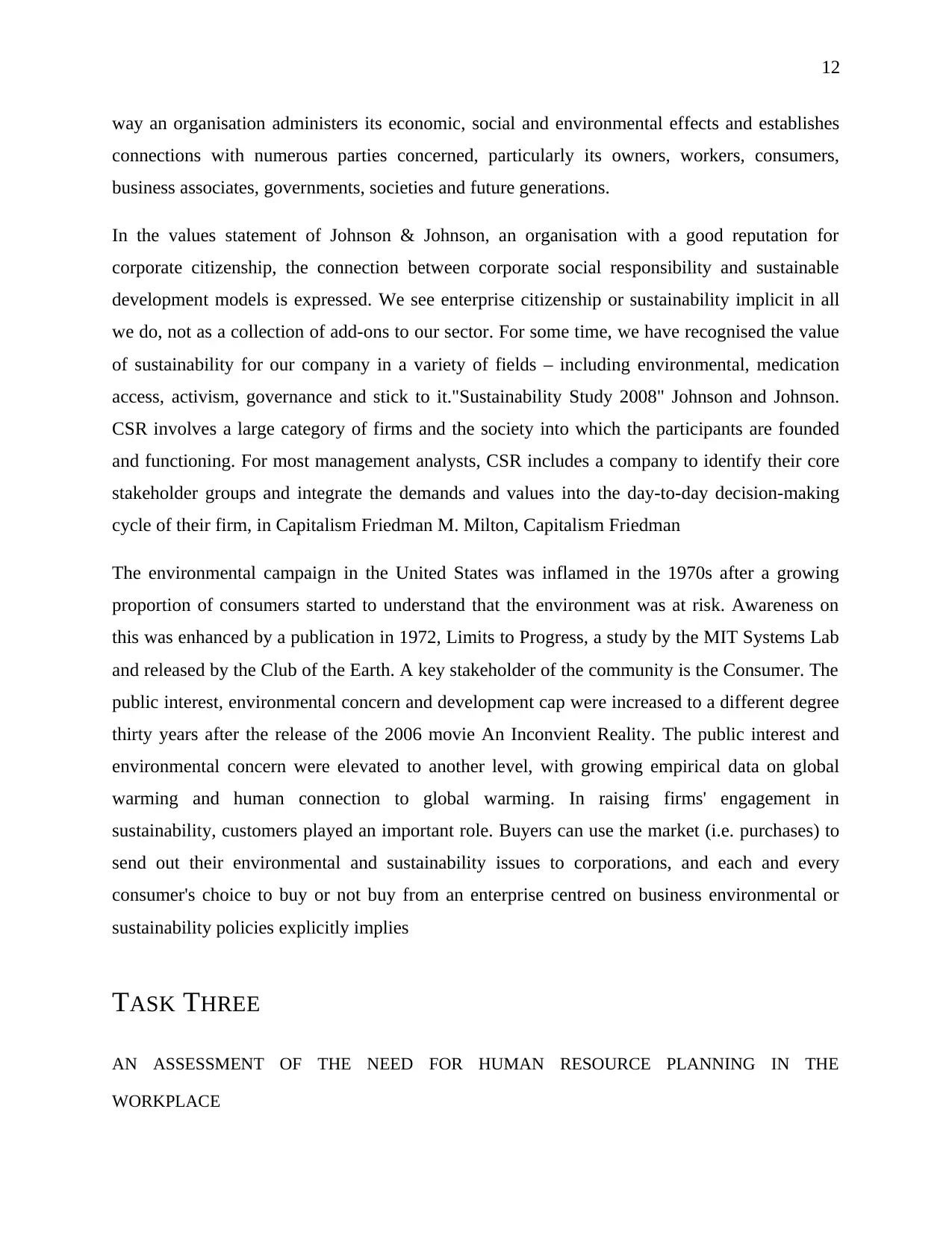
12
way an organisation administers its economic, social and environmental effects and establishes
connections with numerous parties concerned, particularly its owners, workers, consumers,
business associates, governments, societies and future generations.
In the values statement of Johnson & Johnson, an organisation with a good reputation for
corporate citizenship, the connection between corporate social responsibility and sustainable
development models is expressed. We see enterprise citizenship or sustainability implicit in all
we do, not as a collection of add-ons to our sector. For some time, we have recognised the value
of sustainability for our company in a variety of fields – including environmental, medication
access, activism, governance and stick to it."Sustainability Study 2008" Johnson and Johnson.
CSR involves a large category of firms and the society into which the participants are founded
and functioning. For most management analysts, CSR includes a company to identify their core
stakeholder groups and integrate the demands and values into the day-to-day decision-making
cycle of their firm, in Capitalism Friedman M. Milton, Capitalism Friedman
The environmental campaign in the United States was inflamed in the 1970s after a growing
proportion of consumers started to understand that the environment was at risk. Awareness on
this was enhanced by a publication in 1972, Limits to Progress, a study by the MIT Systems Lab
and released by the Club of the Earth. A key stakeholder of the community is the Consumer. The
public interest, environmental concern and development cap were increased to a different degree
thirty years after the release of the 2006 movie An Inconvient Reality. The public interest and
environmental concern were elevated to another level, with growing empirical data on global
warming and human connection to global warming. In raising firms' engagement in
sustainability, customers played an important role. Buyers can use the market (i.e. purchases) to
send out their environmental and sustainability issues to corporations, and each and every
consumer's choice to buy or not buy from an enterprise centred on business environmental or
sustainability policies explicitly implies
TASK THREE
AN ASSESSMENT OF THE NEED FOR HUMAN RESOURCE PLANNING IN THE
WORKPLACE
way an organisation administers its economic, social and environmental effects and establishes
connections with numerous parties concerned, particularly its owners, workers, consumers,
business associates, governments, societies and future generations.
In the values statement of Johnson & Johnson, an organisation with a good reputation for
corporate citizenship, the connection between corporate social responsibility and sustainable
development models is expressed. We see enterprise citizenship or sustainability implicit in all
we do, not as a collection of add-ons to our sector. For some time, we have recognised the value
of sustainability for our company in a variety of fields – including environmental, medication
access, activism, governance and stick to it."Sustainability Study 2008" Johnson and Johnson.
CSR involves a large category of firms and the society into which the participants are founded
and functioning. For most management analysts, CSR includes a company to identify their core
stakeholder groups and integrate the demands and values into the day-to-day decision-making
cycle of their firm, in Capitalism Friedman M. Milton, Capitalism Friedman
The environmental campaign in the United States was inflamed in the 1970s after a growing
proportion of consumers started to understand that the environment was at risk. Awareness on
this was enhanced by a publication in 1972, Limits to Progress, a study by the MIT Systems Lab
and released by the Club of the Earth. A key stakeholder of the community is the Consumer. The
public interest, environmental concern and development cap were increased to a different degree
thirty years after the release of the 2006 movie An Inconvient Reality. The public interest and
environmental concern were elevated to another level, with growing empirical data on global
warming and human connection to global warming. In raising firms' engagement in
sustainability, customers played an important role. Buyers can use the market (i.e. purchases) to
send out their environmental and sustainability issues to corporations, and each and every
consumer's choice to buy or not buy from an enterprise centred on business environmental or
sustainability policies explicitly implies
TASK THREE
AN ASSESSMENT OF THE NEED FOR HUMAN RESOURCE PLANNING IN THE
WORKPLACE
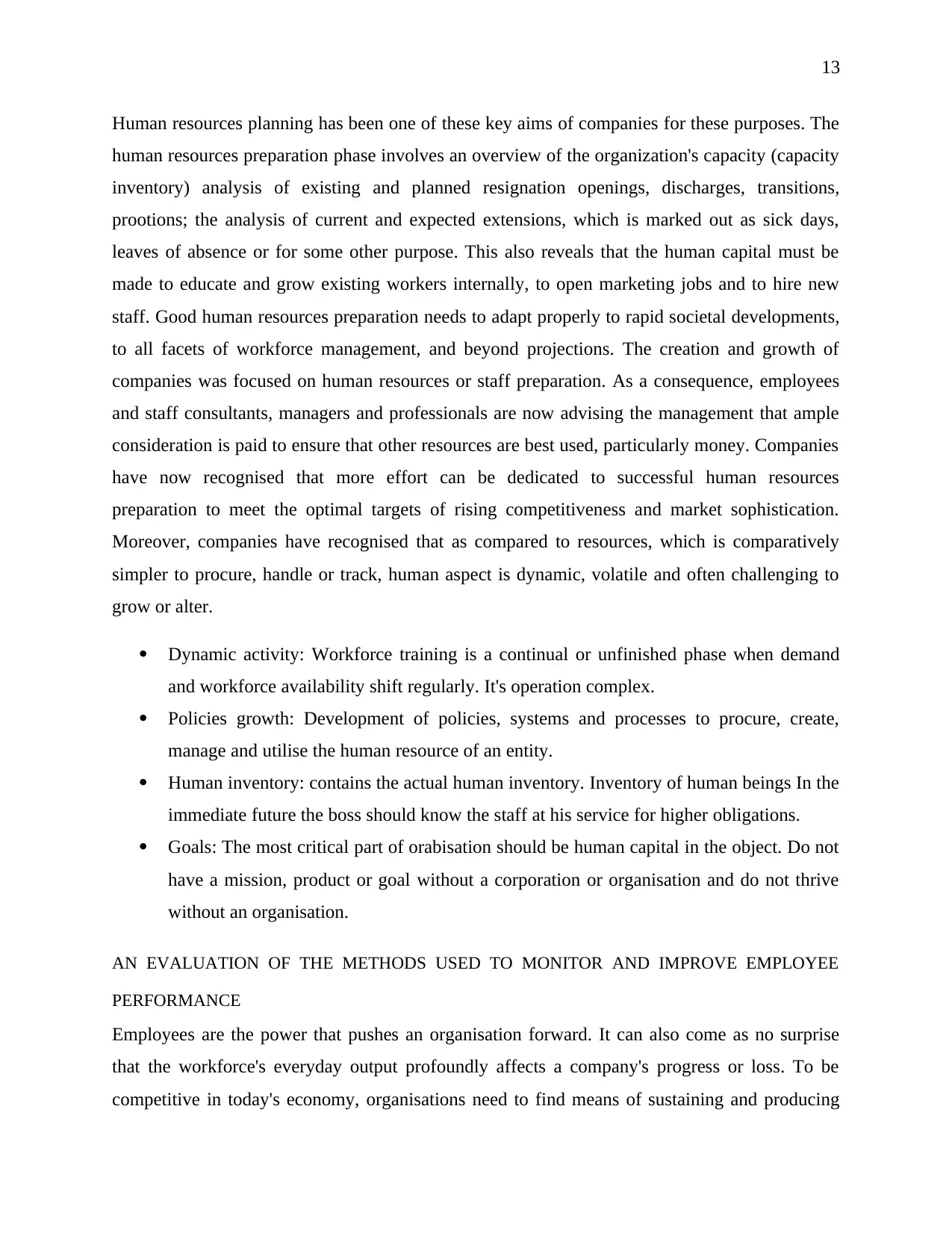
13
Human resources planning has been one of these key aims of companies for these purposes. The
human resources preparation phase involves an overview of the organization's capacity (capacity
inventory) analysis of existing and planned resignation openings, discharges, transitions,
prootions; the analysis of current and expected extensions, which is marked out as sick days,
leaves of absence or for some other purpose. This also reveals that the human capital must be
made to educate and grow existing workers internally, to open marketing jobs and to hire new
staff. Good human resources preparation needs to adapt properly to rapid societal developments,
to all facets of workforce management, and beyond projections. The creation and growth of
companies was focused on human resources or staff preparation. As a consequence, employees
and staff consultants, managers and professionals are now advising the management that ample
consideration is paid to ensure that other resources are best used, particularly money. Companies
have now recognised that more effort can be dedicated to successful human resources
preparation to meet the optimal targets of rising competitiveness and market sophistication.
Moreover, companies have recognised that as compared to resources, which is comparatively
simpler to procure, handle or track, human aspect is dynamic, volatile and often challenging to
grow or alter.
Dynamic activity: Workforce training is a continual or unfinished phase when demand
and workforce availability shift regularly. It's operation complex.
Policies growth: Development of policies, systems and processes to procure, create,
manage and utilise the human resource of an entity.
Human inventory: contains the actual human inventory. Inventory of human beings In the
immediate future the boss should know the staff at his service for higher obligations.
Goals: The most critical part of orabisation should be human capital in the object. Do not
have a mission, product or goal without a corporation or organisation and do not thrive
without an organisation.
AN EVALUATION OF THE METHODS USED TO MONITOR AND IMPROVE EMPLOYEE
PERFORMANCE
Employees are the power that pushes an organisation forward. It can also come as no surprise
that the workforce's everyday output profoundly affects a company's progress or loss. To be
competitive in today's economy, organisations need to find means of sustaining and producing
Human resources planning has been one of these key aims of companies for these purposes. The
human resources preparation phase involves an overview of the organization's capacity (capacity
inventory) analysis of existing and planned resignation openings, discharges, transitions,
prootions; the analysis of current and expected extensions, which is marked out as sick days,
leaves of absence or for some other purpose. This also reveals that the human capital must be
made to educate and grow existing workers internally, to open marketing jobs and to hire new
staff. Good human resources preparation needs to adapt properly to rapid societal developments,
to all facets of workforce management, and beyond projections. The creation and growth of
companies was focused on human resources or staff preparation. As a consequence, employees
and staff consultants, managers and professionals are now advising the management that ample
consideration is paid to ensure that other resources are best used, particularly money. Companies
have now recognised that more effort can be dedicated to successful human resources
preparation to meet the optimal targets of rising competitiveness and market sophistication.
Moreover, companies have recognised that as compared to resources, which is comparatively
simpler to procure, handle or track, human aspect is dynamic, volatile and often challenging to
grow or alter.
Dynamic activity: Workforce training is a continual or unfinished phase when demand
and workforce availability shift regularly. It's operation complex.
Policies growth: Development of policies, systems and processes to procure, create,
manage and utilise the human resource of an entity.
Human inventory: contains the actual human inventory. Inventory of human beings In the
immediate future the boss should know the staff at his service for higher obligations.
Goals: The most critical part of orabisation should be human capital in the object. Do not
have a mission, product or goal without a corporation or organisation and do not thrive
without an organisation.
AN EVALUATION OF THE METHODS USED TO MONITOR AND IMPROVE EMPLOYEE
PERFORMANCE
Employees are the power that pushes an organisation forward. It can also come as no surprise
that the workforce's everyday output profoundly affects a company's progress or loss. To be
competitive in today's economy, organisations need to find means of sustaining and producing
Paraphrase This Document
Need a fresh take? Get an instant paraphrase of this document with our AI Paraphraser
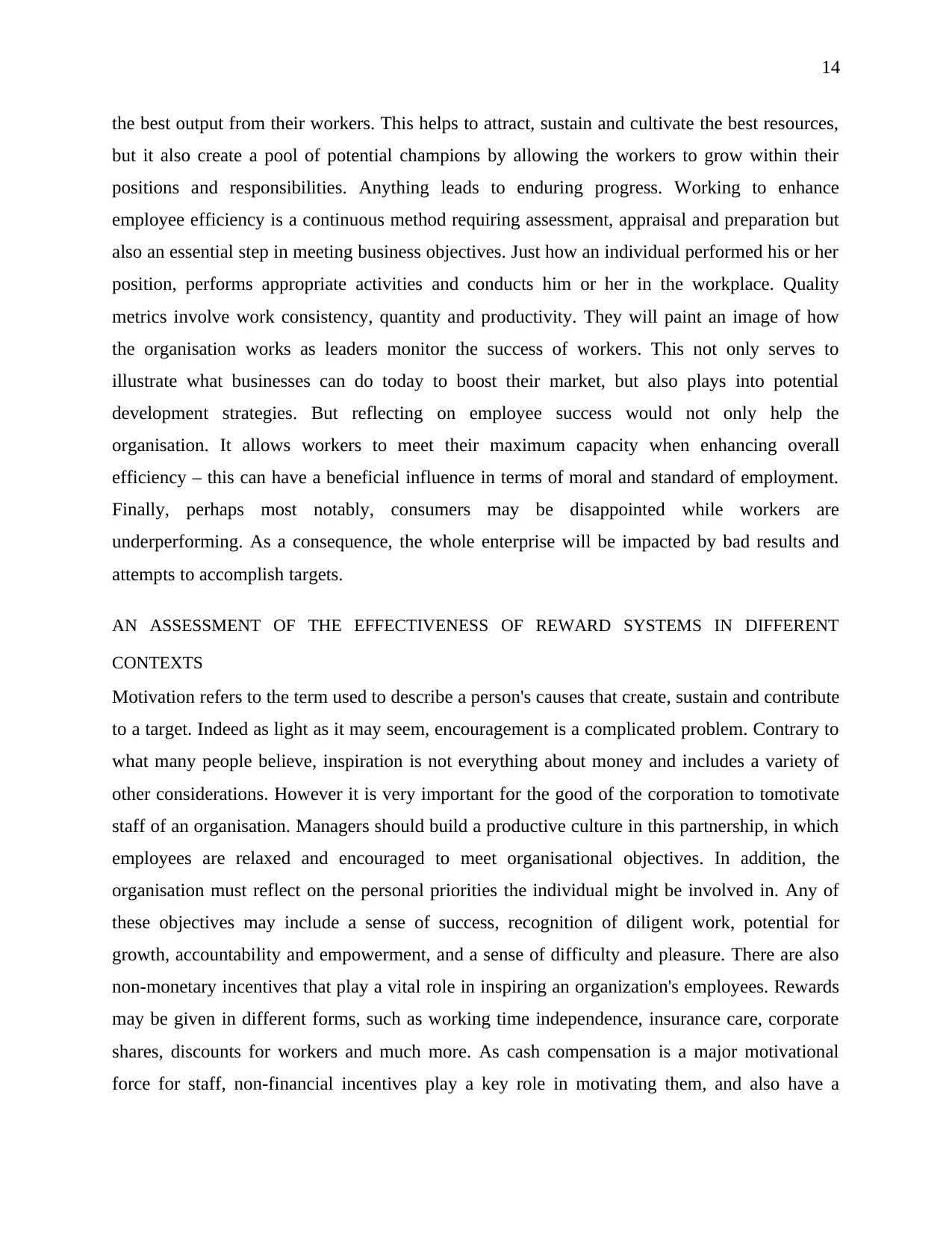
14
the best output from their workers. This helps to attract, sustain and cultivate the best resources,
but it also create a pool of potential champions by allowing the workers to grow within their
positions and responsibilities. Anything leads to enduring progress. Working to enhance
employee efficiency is a continuous method requiring assessment, appraisal and preparation but
also an essential step in meeting business objectives. Just how an individual performed his or her
position, performs appropriate activities and conducts him or her in the workplace. Quality
metrics involve work consistency, quantity and productivity. They will paint an image of how
the organisation works as leaders monitor the success of workers. This not only serves to
illustrate what businesses can do today to boost their market, but also plays into potential
development strategies. But reflecting on employee success would not only help the
organisation. It allows workers to meet their maximum capacity when enhancing overall
efficiency – this can have a beneficial influence in terms of moral and standard of employment.
Finally, perhaps most notably, consumers may be disappointed while workers are
underperforming. As a consequence, the whole enterprise will be impacted by bad results and
attempts to accomplish targets.
AN ASSESSMENT OF THE EFFECTIVENESS OF REWARD SYSTEMS IN DIFFERENT
CONTEXTS
Motivation refers to the term used to describe a person's causes that create, sustain and contribute
to a target. Indeed as light as it may seem, encouragement is a complicated problem. Contrary to
what many people believe, inspiration is not everything about money and includes a variety of
other considerations. However it is very important for the good of the corporation to tomotivate
staff of an organisation. Managers should build a productive culture in this partnership, in which
employees are relaxed and encouraged to meet organisational objectives. In addition, the
organisation must reflect on the personal priorities the individual might be involved in. Any of
these objectives may include a sense of success, recognition of diligent work, potential for
growth, accountability and empowerment, and a sense of difficulty and pleasure. There are also
non-monetary incentives that play a vital role in inspiring an organization's employees. Rewards
may be given in different forms, such as working time independence, insurance care, corporate
shares, discounts for workers and much more. As cash compensation is a major motivational
force for staff, non-financial incentives play a key role in motivating them, and also have a
the best output from their workers. This helps to attract, sustain and cultivate the best resources,
but it also create a pool of potential champions by allowing the workers to grow within their
positions and responsibilities. Anything leads to enduring progress. Working to enhance
employee efficiency is a continuous method requiring assessment, appraisal and preparation but
also an essential step in meeting business objectives. Just how an individual performed his or her
position, performs appropriate activities and conducts him or her in the workplace. Quality
metrics involve work consistency, quantity and productivity. They will paint an image of how
the organisation works as leaders monitor the success of workers. This not only serves to
illustrate what businesses can do today to boost their market, but also plays into potential
development strategies. But reflecting on employee success would not only help the
organisation. It allows workers to meet their maximum capacity when enhancing overall
efficiency – this can have a beneficial influence in terms of moral and standard of employment.
Finally, perhaps most notably, consumers may be disappointed while workers are
underperforming. As a consequence, the whole enterprise will be impacted by bad results and
attempts to accomplish targets.
AN ASSESSMENT OF THE EFFECTIVENESS OF REWARD SYSTEMS IN DIFFERENT
CONTEXTS
Motivation refers to the term used to describe a person's causes that create, sustain and contribute
to a target. Indeed as light as it may seem, encouragement is a complicated problem. Contrary to
what many people believe, inspiration is not everything about money and includes a variety of
other considerations. However it is very important for the good of the corporation to tomotivate
staff of an organisation. Managers should build a productive culture in this partnership, in which
employees are relaxed and encouraged to meet organisational objectives. In addition, the
organisation must reflect on the personal priorities the individual might be involved in. Any of
these objectives may include a sense of success, recognition of diligent work, potential for
growth, accountability and empowerment, and a sense of difficulty and pleasure. There are also
non-monetary incentives that play a vital role in inspiring an organization's employees. Rewards
may be given in different forms, such as working time independence, insurance care, corporate
shares, discounts for workers and much more. As cash compensation is a major motivational
force for staff, non-financial incentives play a key role in motivating them, and also have a
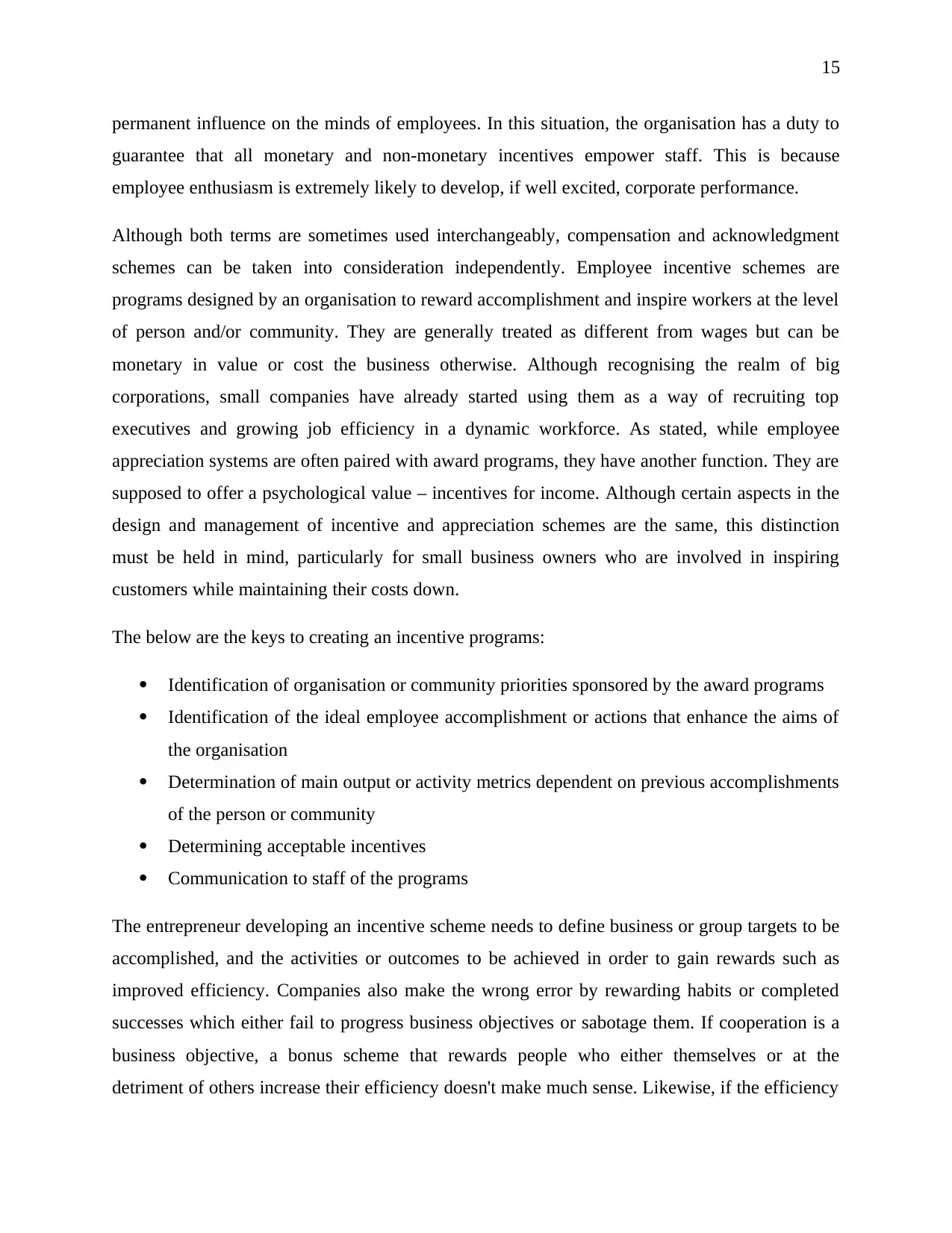
15
permanent influence on the minds of employees. In this situation, the organisation has a duty to
guarantee that all monetary and non-monetary incentives empower staff. This is because
employee enthusiasm is extremely likely to develop, if well excited, corporate performance.
Although both terms are sometimes used interchangeably, compensation and acknowledgment
schemes can be taken into consideration independently. Employee incentive schemes are
programs designed by an organisation to reward accomplishment and inspire workers at the level
of person and/or community. They are generally treated as different from wages but can be
monetary in value or cost the business otherwise. Although recognising the realm of big
corporations, small companies have already started using them as a way of recruiting top
executives and growing job efficiency in a dynamic workforce. As stated, while employee
appreciation systems are often paired with award programs, they have another function. They are
supposed to offer a psychological value – incentives for income. Although certain aspects in the
design and management of incentive and appreciation schemes are the same, this distinction
must be held in mind, particularly for small business owners who are involved in inspiring
customers while maintaining their costs down.
The below are the keys to creating an incentive programs:
Identification of organisation or community priorities sponsored by the award programs
Identification of the ideal employee accomplishment or actions that enhance the aims of
the organisation
Determination of main output or activity metrics dependent on previous accomplishments
of the person or community
Determining acceptable incentives
Communication to staff of the programs
The entrepreneur developing an incentive scheme needs to define business or group targets to be
accomplished, and the activities or outcomes to be achieved in order to gain rewards such as
improved efficiency. Companies also make the wrong error by rewarding habits or completed
successes which either fail to progress business objectives or sabotage them. If cooperation is a
business objective, a bonus scheme that rewards people who either themselves or at the
detriment of others increase their efficiency doesn't make much sense. Likewise, if the efficiency
permanent influence on the minds of employees. In this situation, the organisation has a duty to
guarantee that all monetary and non-monetary incentives empower staff. This is because
employee enthusiasm is extremely likely to develop, if well excited, corporate performance.
Although both terms are sometimes used interchangeably, compensation and acknowledgment
schemes can be taken into consideration independently. Employee incentive schemes are
programs designed by an organisation to reward accomplishment and inspire workers at the level
of person and/or community. They are generally treated as different from wages but can be
monetary in value or cost the business otherwise. Although recognising the realm of big
corporations, small companies have already started using them as a way of recruiting top
executives and growing job efficiency in a dynamic workforce. As stated, while employee
appreciation systems are often paired with award programs, they have another function. They are
supposed to offer a psychological value – incentives for income. Although certain aspects in the
design and management of incentive and appreciation schemes are the same, this distinction
must be held in mind, particularly for small business owners who are involved in inspiring
customers while maintaining their costs down.
The below are the keys to creating an incentive programs:
Identification of organisation or community priorities sponsored by the award programs
Identification of the ideal employee accomplishment or actions that enhance the aims of
the organisation
Determination of main output or activity metrics dependent on previous accomplishments
of the person or community
Determining acceptable incentives
Communication to staff of the programs
The entrepreneur developing an incentive scheme needs to define business or group targets to be
accomplished, and the activities or outcomes to be achieved in order to gain rewards such as
improved efficiency. Companies also make the wrong error by rewarding habits or completed
successes which either fail to progress business objectives or sabotage them. If cooperation is a
business objective, a bonus scheme that rewards people who either themselves or at the
detriment of others increase their efficiency doesn't make much sense. Likewise, if the efficiency
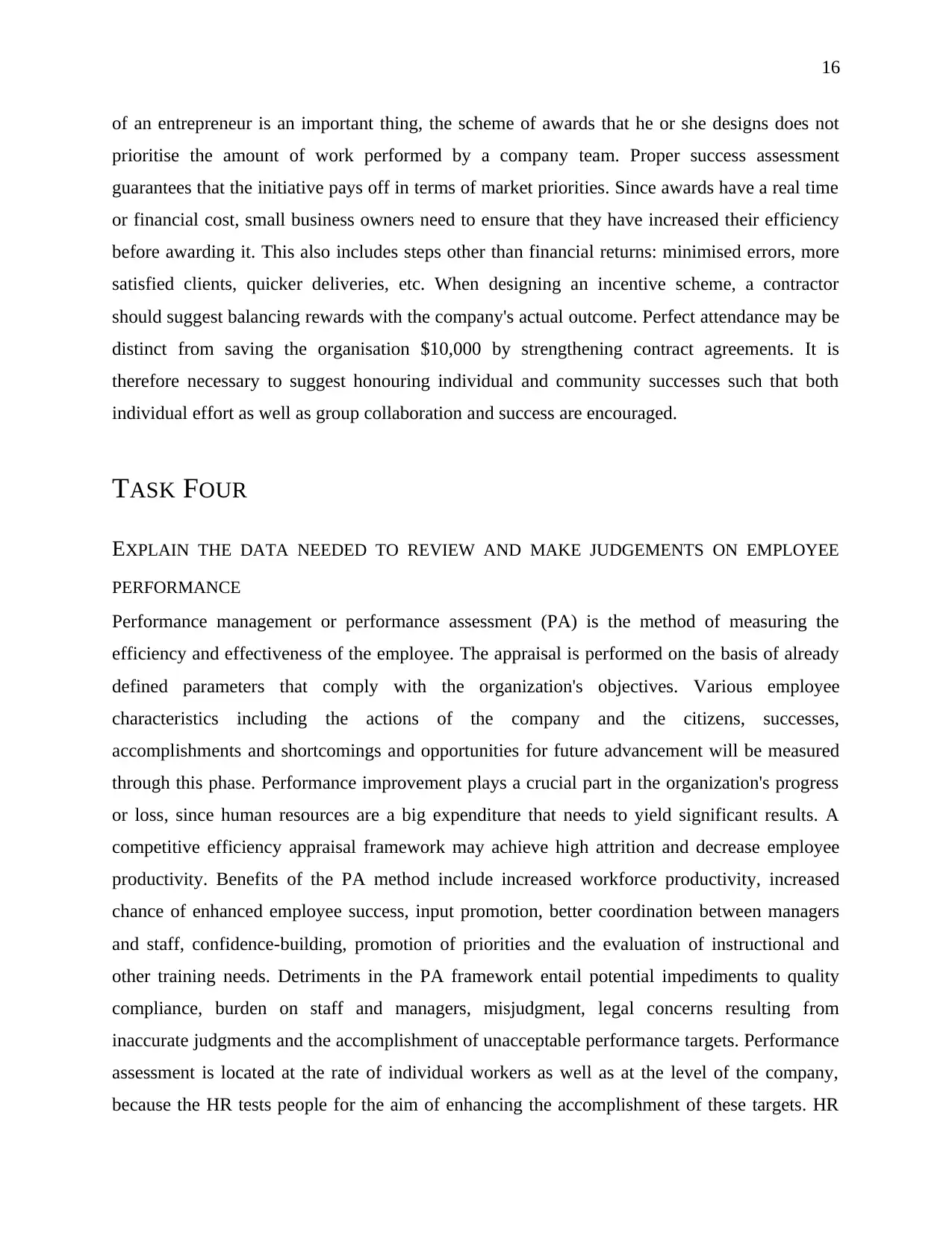
16
of an entrepreneur is an important thing, the scheme of awards that he or she designs does not
prioritise the amount of work performed by a company team. Proper success assessment
guarantees that the initiative pays off in terms of market priorities. Since awards have a real time
or financial cost, small business owners need to ensure that they have increased their efficiency
before awarding it. This also includes steps other than financial returns: minimised errors, more
satisfied clients, quicker deliveries, etc. When designing an incentive scheme, a contractor
should suggest balancing rewards with the company's actual outcome. Perfect attendance may be
distinct from saving the organisation $10,000 by strengthening contract agreements. It is
therefore necessary to suggest honouring individual and community successes such that both
individual effort as well as group collaboration and success are encouraged.
TASK FOUR
EXPLAIN THE DATA NEEDED TO REVIEW AND MAKE JUDGEMENTS ON EMPLOYEE
PERFORMANCE
Performance management or performance assessment (PA) is the method of measuring the
efficiency and effectiveness of the employee. The appraisal is performed on the basis of already
defined parameters that comply with the organization's objectives. Various employee
characteristics including the actions of the company and the citizens, successes,
accomplishments and shortcomings and opportunities for future advancement will be measured
through this phase. Performance improvement plays a crucial part in the organization's progress
or loss, since human resources are a big expenditure that needs to yield significant results. A
competitive efficiency appraisal framework may achieve high attrition and decrease employee
productivity. Benefits of the PA method include increased workforce productivity, increased
chance of enhanced employee success, input promotion, better coordination between managers
and staff, confidence-building, promotion of priorities and the evaluation of instructional and
other training needs. Detriments in the PA framework entail potential impediments to quality
compliance, burden on staff and managers, misjudgment, legal concerns resulting from
inaccurate judgments and the accomplishment of unacceptable performance targets. Performance
assessment is located at the rate of individual workers as well as at the level of the company,
because the HR tests people for the aim of enhancing the accomplishment of these targets. HR
of an entrepreneur is an important thing, the scheme of awards that he or she designs does not
prioritise the amount of work performed by a company team. Proper success assessment
guarantees that the initiative pays off in terms of market priorities. Since awards have a real time
or financial cost, small business owners need to ensure that they have increased their efficiency
before awarding it. This also includes steps other than financial returns: minimised errors, more
satisfied clients, quicker deliveries, etc. When designing an incentive scheme, a contractor
should suggest balancing rewards with the company's actual outcome. Perfect attendance may be
distinct from saving the organisation $10,000 by strengthening contract agreements. It is
therefore necessary to suggest honouring individual and community successes such that both
individual effort as well as group collaboration and success are encouraged.
TASK FOUR
EXPLAIN THE DATA NEEDED TO REVIEW AND MAKE JUDGEMENTS ON EMPLOYEE
PERFORMANCE
Performance management or performance assessment (PA) is the method of measuring the
efficiency and effectiveness of the employee. The appraisal is performed on the basis of already
defined parameters that comply with the organization's objectives. Various employee
characteristics including the actions of the company and the citizens, successes,
accomplishments and shortcomings and opportunities for future advancement will be measured
through this phase. Performance improvement plays a crucial part in the organization's progress
or loss, since human resources are a big expenditure that needs to yield significant results. A
competitive efficiency appraisal framework may achieve high attrition and decrease employee
productivity. Benefits of the PA method include increased workforce productivity, increased
chance of enhanced employee success, input promotion, better coordination between managers
and staff, confidence-building, promotion of priorities and the evaluation of instructional and
other training needs. Detriments in the PA framework entail potential impediments to quality
compliance, burden on staff and managers, misjudgment, legal concerns resulting from
inaccurate judgments and the accomplishment of unacceptable performance targets. Performance
assessment is located at the rate of individual workers as well as at the level of the company,
because the HR tests people for the aim of enhancing the accomplishment of these targets. HR
Secure Best Marks with AI Grader
Need help grading? Try our AI Grader for instant feedback on your assignments.
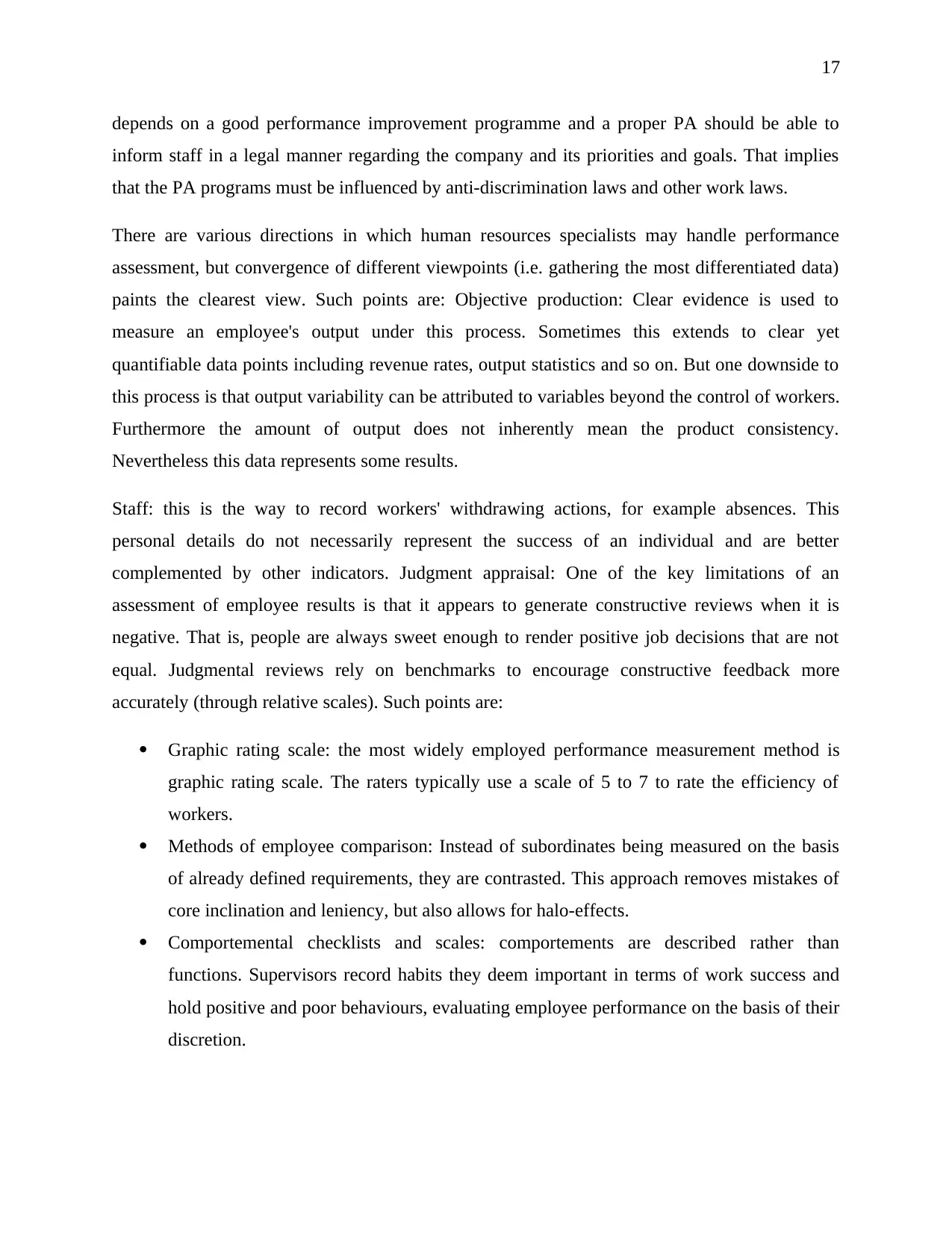
17
depends on a good performance improvement programme and a proper PA should be able to
inform staff in a legal manner regarding the company and its priorities and goals. That implies
that the PA programs must be influenced by anti-discrimination laws and other work laws.
There are various directions in which human resources specialists may handle performance
assessment, but convergence of different viewpoints (i.e. gathering the most differentiated data)
paints the clearest view. Such points are: Objective production: Clear evidence is used to
measure an employee's output under this process. Sometimes this extends to clear yet
quantifiable data points including revenue rates, output statistics and so on. But one downside to
this process is that output variability can be attributed to variables beyond the control of workers.
Furthermore the amount of output does not inherently mean the product consistency.
Nevertheless this data represents some results.
Staff: this is the way to record workers' withdrawing actions, for example absences. This
personal details do not necessarily represent the success of an individual and are better
complemented by other indicators. Judgment appraisal: One of the key limitations of an
assessment of employee results is that it appears to generate constructive reviews when it is
negative. That is, people are always sweet enough to render positive job decisions that are not
equal. Judgmental reviews rely on benchmarks to encourage constructive feedback more
accurately (through relative scales). Such points are:
Graphic rating scale: the most widely employed performance measurement method is
graphic rating scale. The raters typically use a scale of 5 to 7 to rate the efficiency of
workers.
Methods of employee comparison: Instead of subordinates being measured on the basis
of already defined requirements, they are contrasted. This approach removes mistakes of
core inclination and leniency, but also allows for halo-effects.
Comportemental checklists and scales: comportements are described rather than
functions. Supervisors record habits they deem important in terms of work success and
hold positive and poor behaviours, evaluating employee performance on the basis of their
discretion.
depends on a good performance improvement programme and a proper PA should be able to
inform staff in a legal manner regarding the company and its priorities and goals. That implies
that the PA programs must be influenced by anti-discrimination laws and other work laws.
There are various directions in which human resources specialists may handle performance
assessment, but convergence of different viewpoints (i.e. gathering the most differentiated data)
paints the clearest view. Such points are: Objective production: Clear evidence is used to
measure an employee's output under this process. Sometimes this extends to clear yet
quantifiable data points including revenue rates, output statistics and so on. But one downside to
this process is that output variability can be attributed to variables beyond the control of workers.
Furthermore the amount of output does not inherently mean the product consistency.
Nevertheless this data represents some results.
Staff: this is the way to record workers' withdrawing actions, for example absences. This
personal details do not necessarily represent the success of an individual and are better
complemented by other indicators. Judgment appraisal: One of the key limitations of an
assessment of employee results is that it appears to generate constructive reviews when it is
negative. That is, people are always sweet enough to render positive job decisions that are not
equal. Judgmental reviews rely on benchmarks to encourage constructive feedback more
accurately (through relative scales). Such points are:
Graphic rating scale: the most widely employed performance measurement method is
graphic rating scale. The raters typically use a scale of 5 to 7 to rate the efficiency of
workers.
Methods of employee comparison: Instead of subordinates being measured on the basis
of already defined requirements, they are contrasted. This approach removes mistakes of
core inclination and leniency, but also allows for halo-effects.
Comportemental checklists and scales: comportements are described rather than
functions. Supervisors record habits they deem important in terms of work success and
hold positive and poor behaviours, evaluating employee performance on the basis of their
discretion.
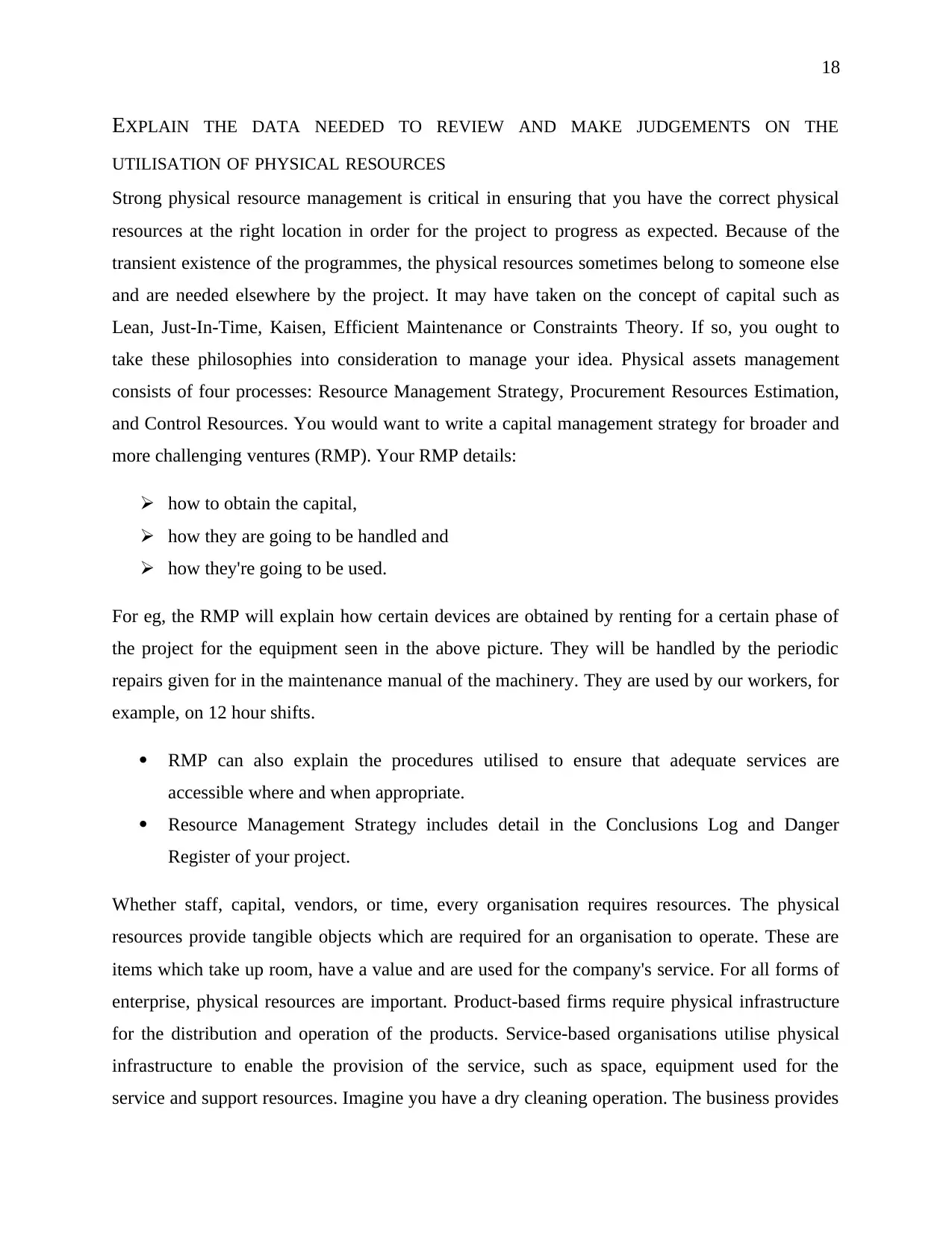
18
EXPLAIN THE DATA NEEDED TO REVIEW AND MAKE JUDGEMENTS ON THE
UTILISATION OF PHYSICAL RESOURCES
Strong physical resource management is critical in ensuring that you have the correct physical
resources at the right location in order for the project to progress as expected. Because of the
transient existence of the programmes, the physical resources sometimes belong to someone else
and are needed elsewhere by the project. It may have taken on the concept of capital such as
Lean, Just-In-Time, Kaisen, Efficient Maintenance or Constraints Theory. If so, you ought to
take these philosophies into consideration to manage your idea. Physical assets management
consists of four processes: Resource Management Strategy, Procurement Resources Estimation,
and Control Resources. You would want to write a capital management strategy for broader and
more challenging ventures (RMP). Your RMP details:
how to obtain the capital,
how they are going to be handled and
how they're going to be used.
For eg, the RMP will explain how certain devices are obtained by renting for a certain phase of
the project for the equipment seen in the above picture. They will be handled by the periodic
repairs given for in the maintenance manual of the machinery. They are used by our workers, for
example, on 12 hour shifts.
RMP can also explain the procedures utilised to ensure that adequate services are
accessible where and when appropriate.
Resource Management Strategy includes detail in the Conclusions Log and Danger
Register of your project.
Whether staff, capital, vendors, or time, every organisation requires resources. The physical
resources provide tangible objects which are required for an organisation to operate. These are
items which take up room, have a value and are used for the company's service. For all forms of
enterprise, physical resources are important. Product-based firms require physical infrastructure
for the distribution and operation of the products. Service-based organisations utilise physical
infrastructure to enable the provision of the service, such as space, equipment used for the
service and support resources. Imagine you have a dry cleaning operation. The business provides
EXPLAIN THE DATA NEEDED TO REVIEW AND MAKE JUDGEMENTS ON THE
UTILISATION OF PHYSICAL RESOURCES
Strong physical resource management is critical in ensuring that you have the correct physical
resources at the right location in order for the project to progress as expected. Because of the
transient existence of the programmes, the physical resources sometimes belong to someone else
and are needed elsewhere by the project. It may have taken on the concept of capital such as
Lean, Just-In-Time, Kaisen, Efficient Maintenance or Constraints Theory. If so, you ought to
take these philosophies into consideration to manage your idea. Physical assets management
consists of four processes: Resource Management Strategy, Procurement Resources Estimation,
and Control Resources. You would want to write a capital management strategy for broader and
more challenging ventures (RMP). Your RMP details:
how to obtain the capital,
how they are going to be handled and
how they're going to be used.
For eg, the RMP will explain how certain devices are obtained by renting for a certain phase of
the project for the equipment seen in the above picture. They will be handled by the periodic
repairs given for in the maintenance manual of the machinery. They are used by our workers, for
example, on 12 hour shifts.
RMP can also explain the procedures utilised to ensure that adequate services are
accessible where and when appropriate.
Resource Management Strategy includes detail in the Conclusions Log and Danger
Register of your project.
Whether staff, capital, vendors, or time, every organisation requires resources. The physical
resources provide tangible objects which are required for an organisation to operate. These are
items which take up room, have a value and are used for the company's service. For all forms of
enterprise, physical resources are important. Product-based firms require physical infrastructure
for the distribution and operation of the products. Service-based organisations utilise physical
infrastructure to enable the provision of the service, such as space, equipment used for the
service and support resources. Imagine you have a dry cleaning operation. The business provides
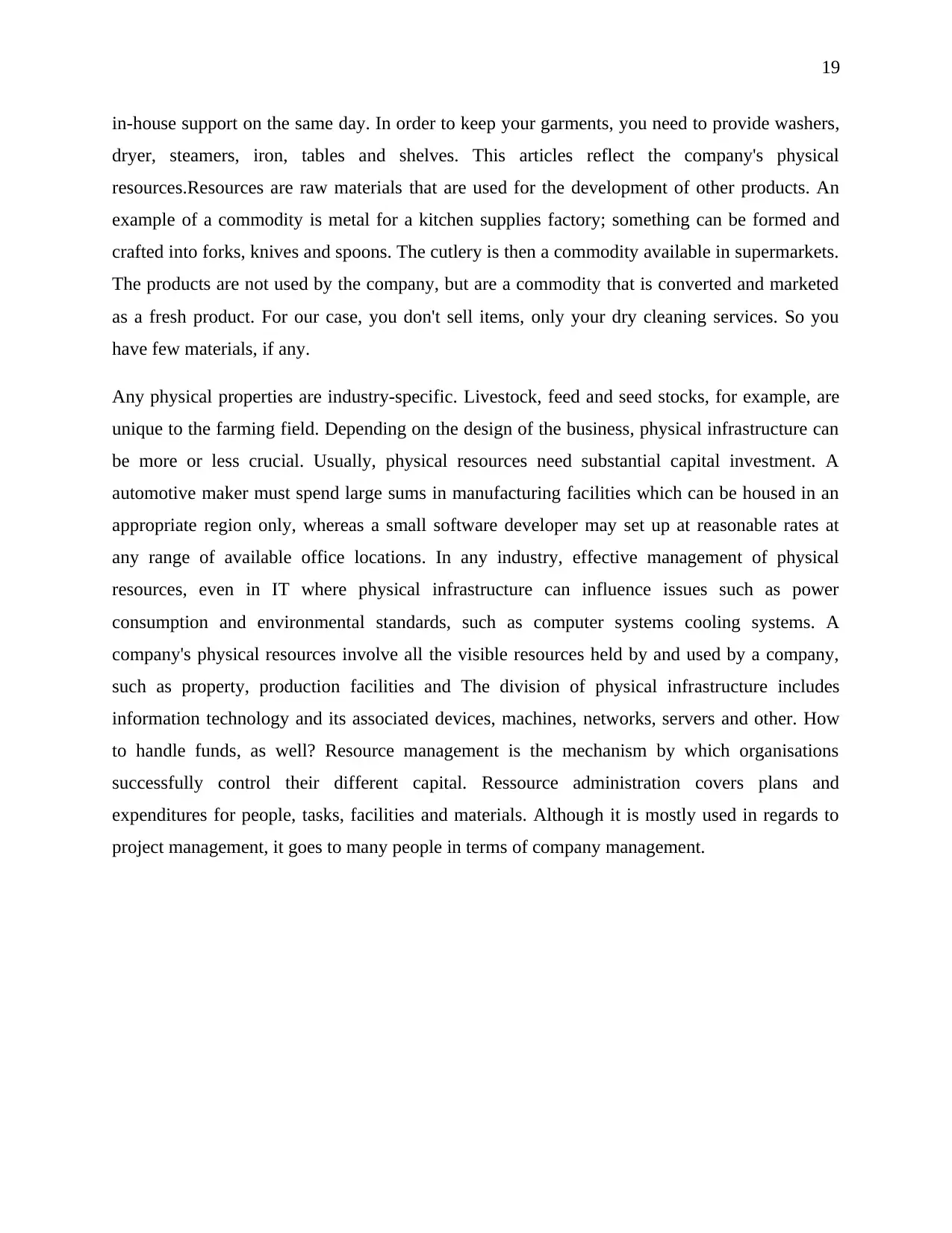
19
in-house support on the same day. In order to keep your garments, you need to provide washers,
dryer, steamers, iron, tables and shelves. This articles reflect the company's physical
resources.Resources are raw materials that are used for the development of other products. An
example of a commodity is metal for a kitchen supplies factory; something can be formed and
crafted into forks, knives and spoons. The cutlery is then a commodity available in supermarkets.
The products are not used by the company, but are a commodity that is converted and marketed
as a fresh product. For our case, you don't sell items, only your dry cleaning services. So you
have few materials, if any.
Any physical properties are industry-specific. Livestock, feed and seed stocks, for example, are
unique to the farming field. Depending on the design of the business, physical infrastructure can
be more or less crucial. Usually, physical resources need substantial capital investment. A
automotive maker must spend large sums in manufacturing facilities which can be housed in an
appropriate region only, whereas a small software developer may set up at reasonable rates at
any range of available office locations. In any industry, effective management of physical
resources, even in IT where physical infrastructure can influence issues such as power
consumption and environmental standards, such as computer systems cooling systems. A
company's physical resources involve all the visible resources held by and used by a company,
such as property, production facilities and The division of physical infrastructure includes
information technology and its associated devices, machines, networks, servers and other. How
to handle funds, as well? Resource management is the mechanism by which organisations
successfully control their different capital. Ressource administration covers plans and
expenditures for people, tasks, facilities and materials. Although it is mostly used in regards to
project management, it goes to many people in terms of company management.
in-house support on the same day. In order to keep your garments, you need to provide washers,
dryer, steamers, iron, tables and shelves. This articles reflect the company's physical
resources.Resources are raw materials that are used for the development of other products. An
example of a commodity is metal for a kitchen supplies factory; something can be formed and
crafted into forks, knives and spoons. The cutlery is then a commodity available in supermarkets.
The products are not used by the company, but are a commodity that is converted and marketed
as a fresh product. For our case, you don't sell items, only your dry cleaning services. So you
have few materials, if any.
Any physical properties are industry-specific. Livestock, feed and seed stocks, for example, are
unique to the farming field. Depending on the design of the business, physical infrastructure can
be more or less crucial. Usually, physical resources need substantial capital investment. A
automotive maker must spend large sums in manufacturing facilities which can be housed in an
appropriate region only, whereas a small software developer may set up at reasonable rates at
any range of available office locations. In any industry, effective management of physical
resources, even in IT where physical infrastructure can influence issues such as power
consumption and environmental standards, such as computer systems cooling systems. A
company's physical resources involve all the visible resources held by and used by a company,
such as property, production facilities and The division of physical infrastructure includes
information technology and its associated devices, machines, networks, servers and other. How
to handle funds, as well? Resource management is the mechanism by which organisations
successfully control their different capital. Ressource administration covers plans and
expenditures for people, tasks, facilities and materials. Although it is mostly used in regards to
project management, it goes to many people in terms of company management.
1 out of 19
Related Documents
Your All-in-One AI-Powered Toolkit for Academic Success.
+13062052269
info@desklib.com
Available 24*7 on WhatsApp / Email
![[object Object]](/_next/static/media/star-bottom.7253800d.svg)
Unlock your academic potential
© 2024 | Zucol Services PVT LTD | All rights reserved.





![[SOLVED] Analysis of Dalata Hotel Group plc](/_next/image/?url=https%3A%2F%2Fdesklib.com%2Fmedia%2Fimages%2Fzp%2F6d399af6704c49b9851b41a8edf13dcb.jpg&w=256&q=75)